











COZY BY DESIGN













COZY BY DESIGN
Frost lingers on evergreens, snow settles in soft, sculpted forms — each detail a reflection of winter’s quiet artistry. A landscape that breathes with the season, still yet full of life, where beauty and balance come naturally. Designed for harmony, shaped by nature.

















Gorgeous sunsets, fresh breeze, and great company—with a custom Hutten & Co. landscape, you’ll never want to go inside.




































W O R K S M A R T E R . E V E R Y S E A S O N .



















COLLEGE & UNIVERSITY
Lift Tickets $69*
MONDAY TO FRIDAY
When campus chaos peaks and your brain’s ready to bail, it’s time to trade cram sessions for chairlifts. Take a study break that actually works — carve it out on the hill and come back clear-headed.
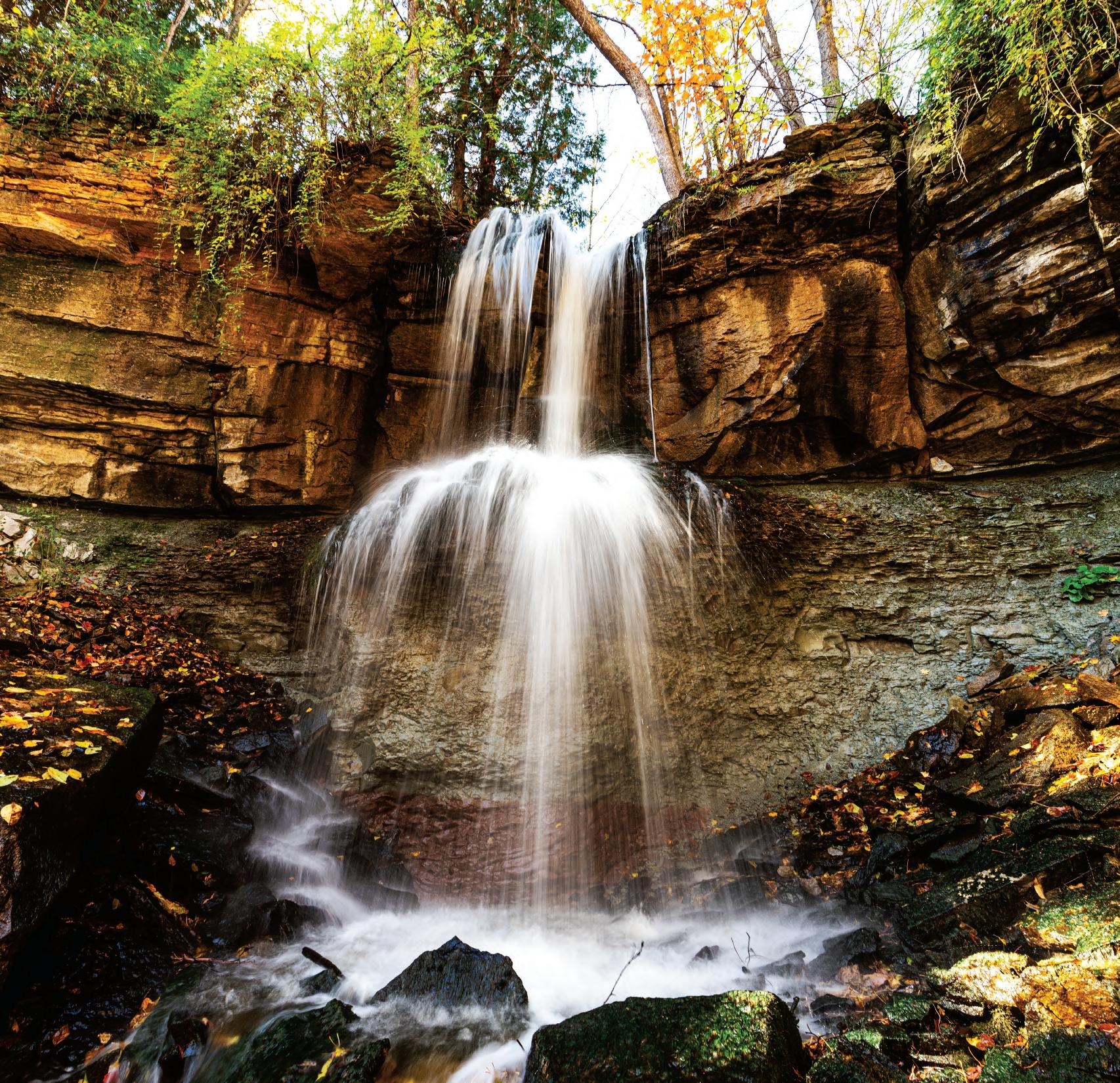






Cara Williams Editor-In-Chief cara@escarpmentmagazine.ca

As autumn settles across the Escarpment, the landscape takes on its most dazzling transformation. Hillsides blaze with colour, orchards brim with apples, and evenings grow crisp—a gentle reminder that winter waits in the wings.
In France, they call this time of year la rentrée—a season of reentry and renewal. I love that idea; for me, it is also a reminder to be present, because autumn is fleeting. One strong wind can strip the trees of their colour—one early snowfall can shift our focus forward. I find it in the crunch of leaves underfoot, the sharp tang of frost in the air, and the quiet anticipation of what winter will bring.
I can’t wait!
This issue embraces that balance between presence and anticipation. You’ll find inspiration
in nature, in the creativity of local artists, in the beauty of an extraordinary home, and in the passion of an athlete chasing Olympic dreams. Each page is an invitation to pause, to linger, and to celebrate the changing seasons in all their richness—while welcoming what’s ahead.
As we close out the year, I’m reminded that each season on the Escarpment has its own gifts. Autumn asks us to take notice; early winter urges us to embrace momentum, to lean into the slope, skis at the ready. My hope is that these pages inspire you to savour the moment you’re in—and to look forward with joy to the turns still to come.


GEORGIAN BAY LIVING



PUBLISHER/OWNER
Clay Dolan clay@escarpmentmagazine.ca
EDITOR- IN - CHIEF
Cara Williams cara@escarpmentmagazine.ca
ART DIRECTOR
Bradley Reinhardt bradley@escarpmentmagazine.ca
GRAPHIC DESIGNER
Alyshia Laube alyshia@escarpmentmagazine.ca
Katie Ballantyne, Shirra Benson, Jesse Bell, Gill Cameron, Don Campbell, Sarah Carlson, Kelsey Chernes, Nicole D’Amico, Kennedy Deneau, Deena Dolan, Andrew Dzenis, Nick Eyles, Heather Fields, Marc Huminilowycz, Serena Kelly, Rick Layzell, Brendan Mackay, Shannon MacDougall, Kate MacLennan, Ken Maher, Marcia Masino, Wade Mitchell, Mark O’Grady, Len Pizzey, Robert Saunders, Melissa Shaw, Kirstin Shollig, Riley Snelling, Catherine Staples, Kianna Sunshine, May Tettero, Sky Tettero-Crosby, William Tam, Robin Todd, Aidan Ware, Jody Wilson, Shelby Worts
ADVERTISING DIRECTOR
Geoffrey Cameron 416.910.9649
geoff@escarpmentmagazine.ca
OFFICE 519.599.7545 MARKETING &
info@escarpmentmagazine.ca
Escarpment® is published four times a year by Georgian Bay Living— Escarpment® Magazine Inc. 25,000 copies. Distributed free of charge to hotels, shops, clubs, businesses and services all throughout Simcoe, Grey & Bruce Counties.
Paid Subscription holders have guaranteed mail delivery. Attention Postmaster: Please direct post office returns and changes of address to GBL—Escarpment® Magazine Inc., 183 Marsh Street, Unit 4, PO Box 107, Clarksburg, ON, N0H 1J0
Subscription rate: 4 issues (one year), $22.75 HST incl.
No part or portions of this publication may be reproduced without written permission of the Editor. Opinions and statements written by contributors of Escarpment® and that appear in this issue or others are entirely their own responsibility and do not necessarily reflect the opinions of the owner of GBL—Escarpment® Magazine Inc.
Georgian Bay Living—Escarpment Magazine® and Escarpment® is a registered trademark of Georgian Bay Living— Escarpment® Magazine Inc. ©2025 All rights reserved.
Escarpment is printed in a Canadian facility that operates in strict compliance with environmental standards.



Nathan is a Chartered Professional Accountant with over 15 years of experience in Canadian taxation, having practiced at national firms. His expertise spans personal and corporate tax planning, business structuring, estate and family trust planning, and advising clients on acquisitions and sales of businesses. He has a particular passion for guiding families through intergenerational transfers of businesses and farms, helping Canadian entrepreneurs grow, succeed, and transition family wealth in a tax-efficient way.
Nathan believes in a collaborative approach, working closely with clients and their legal, wealth, and insurance advisors to provide peace of mind and ensure every aspect of their financial and tax affairs is handled with care and precision.
A lifelong learner and leader in his field, Nathan has completed both the CPA Canada In-Depth Tax Course and the CPA Canada In-Depth Corporate Reorganization Tax Course. He has also presented at the Canadian Tax Foundation’s Annual Tax Conference and contributed to training programs and resources for CPA Canada and the Canadian Tax Foundation.
Outside of work, Nathan and his wife, Elisha, are proud parents to three children who keep them busy with a wide range of sports and activities.

Equal parts boardwalk stroll, wetland walk, ridgeline trek, and a trip through time, a hike through the Bognor Marsh is a total surprise and delight.
By Kate MacLennan | Photography by Clay Dolan


hikes, the wonders of the natural world are impossible to miss: sweeping valley vistas, waterscapes, waterfalls, and forests so enchanting you think you’ve stumbled into a fairy tale. Hikers are drawn to such trails like moths to a flame, but not so much to the modest marsh, which lies low, reedy, and mucky in comparison. This, hiking friends, is a major oversight.
Consider the Bognor Marsh. Arguably not named for marketing appeal, this mineral-rich, shallow wetland makes up for it in hiking and biodiversity. Protected marsh areas like this are treasure troves of genetic variability—home to diverse species and ecosystems, and a window through which to peer at the relationships between them. They’re a snapshot of a story still being written by (or perhaps about) planet Earth: that of life’s miraculous adaptation, survival, and persistence. Seriously, it is—and hikers can access it all via 11.9 kilometres of trail that twists through 668 hectares of one of the largest marsh systems in Grey County.
Like most things we take for granted as part of Earth, this marsh didn’t always exist. The Bognor Marsh was created in 1958 when the Grey Sauble Conservation Authority (GSCA) constructed an earthen dyke and metal culvert control structure to flood 70 acres of land. In the late 1960s, the dyke washed out after being hammered by repeated years of heavy spring run-off and enthusiastic muskrat activity. Ducks Unlimited approached GSCA
in 1975 to offer assistance in re-establishing the marsh. A new 700foot dyke and two-bay concrete spillway were completed in 1977, creating the 100 acres known today as Bognor Marsh.
Rebecca Anthony, Manager of Conservation Lands for GSCA, explains why the area is worth all the trouble. “Conservation is about protecting plants and wildlife, and it’s also about protecting people. Natural areas like Bognor Marsh provide flood protection, help keep water clean, reduce CO2 emissions, and are home to countless species. They also give us places to connect, recharge, and stay healthy—and contribute to a stronger local economy through tourism, recreation, and reduced infrastructure costs. When we care for these places, we’re also investing in our own well-being and the future of our communities,” she says.
Today this multi-use area attracts hikers (including those looking for Bruce Trail access), naturalists, birders, school groups, and hunters (during the fall season). Most hikers start their exploration at the small pay-parking lot just off Grey County Road 18, between Owen Sound and Meaford. (The Grey County Conservation Area annual parking pass works here; otherwise, the cost is $10 + HST per day. Additional roadside parking on 4th Concession North connects directly to a 7-kilometre loop through the marsh.)
From the parking lot, you’ll strike out along a short, treed access road before arriving at the well-maintained floating








“NATURAL
AREAS LIKE BOGNOR MARSH PROVIDE FLOOD PROTECTION, HELP KEEP WATER CLEAN, REDUCE CO2 EMISSIONS, AND ARE HOME TO COUNTLESS SPECIES. THEY ALSO GIVE US PLACES TO CONNECT, RECHARGE, AND STAY HEALTHY.”
boardwalk that winds unobtrusively through the marsh. Along the boardwalk are signs to educate visitors about the area’s ecology and wildlife. Many, however, are weather-beaten, so it’s worth having the means to jot down points of interest to research later at home.
This marsh—one of three that are part of the Bognor Marsh Management Area— greets everyone with the sounds of the season. Imagine spring peepers and birdsong, the croak of bullfrogs, the hoot of an owl, fall crickets, migrating geese, the raspy scream of a hawk, and the blissful silence of winter. Birders perch in the Bognor Marsh’s observation tower for a glimpse of warblers, black tern, least bittern, pied-billed grebe, ovenbird, and thrush. Not to mention hummingbirds, red-winged blackbirds, grosbeak, redstart, Virginia rail, sparrow, crane, hawk, heron, kingfisher, ducks, egret, wild turkey—and the list goes on.
A Ducks Unlimited dam and a beaver lodge are easy to pick out from the boardwalk. Turtle nesting sites are also present, as are many frogs— not to mention deer and black bear, who leave behind tell-tale tracks and scat.
Plant communities vary based on the depth of the water and the “water level drawdown cycle” (a rating dependent on whether water is present all year, every spring, only in spring, etc.). The marsh consists of three major plant zones. The Emergent Zone, the shallow area along the shoreline of the swamp, is replete with plants that grow with their roots and bases in wet soil or water while the rest of the plant is above the water (think: sphagnum or “peat” moss, horsetail, sedge, arrowhead).

Where the water deepens, the Floating-Leaved Zone becomes apparent. These plants are rooted in the deeper water but tend to send up broad floating leaves to the surface (think: floating pondweed and white waterlily). Finally, in the Submergent Zone are plants that are generally rooted and extend stems and leaves entirely underwater (such as Northern watermilfoil and stonewort).
By mid to late summer, blazes of pink, purple, red, and yellow wildflowers (including easily recognizable species such as sweet JoePye weed, wild carrot, and goldenrod) grow thick and high beside the lowland trails and literally buzz with pollinating insects. Less friendly species of plants and bugs—like poison ivy and ticks—also thrive here, making long pants, socks, and hiking boots a wise choice. The very nature of a marsh is that its water levels fluctuate annually, seasonally, or even daily. When hiking in any season, assume your feet will get wet and observe the golden rule of hiking: stay on the trail, even if you have to wade through some parts of it.
Each autumn the mineral-rich soils, blue-grey or a mottled
red-brown, disappear beneath the faded yellows and umber of decaying plant life across the marsh. Above it, however, the Escarpment upland forests put on a display of vivid fall colours that will stop any hiker in their tracks.
Spoiler alert: the Bognor Marsh loop trail (well marked and just over 4 kilometres long) includes a spectacular view in all seasons, but particularly in autumn. To experience it, you’ll need to march up a reasonably steep incline. It’s not long, but it’s challenging enough to warrant trekking poles for less stable hikers. In wet weather or snowfall, footwear with grippy lugs or snowshoes with crampons are an asset for anybody. On this section of the trail, you’ll comfortably hike the edge of the Escarpment, with a panoramic view over the marsh below. Here, the wind rushes up, clean and fresh, seeming to tickle the most primal areas of your brain. “You, too, are a part of all of this,” it seems to whisper, if you’re really listening.
And you are a part of all of it, even after you descend back down the loop trail and hike out to your vehicle. Long after you return home. In all likelihood, for millennia after the last footsteps of humanity leave their mark on the Bognor Marsh. E

It’s for good reason. Advisors cultivate results over long time frames by harnessing expertise and resources across many different areas of the wealth spectrum. We work with families, businesses and private investors to provide professional guidance on all financial matters.

with: • Bespoke investment and wealth management strategies • Ongoing financial education, context and support • Detailed financial planning • Tax minimization strategies • Estate planning and Will reviews

NOW WITH EVEN MORE BRANDS FOR EVERY ADVENTURE THAT COMES YOUR WAY
February 5, 2025
-Juicer, Orchard

DAYS, YOUR WAY.
Schedules shift, storms hit, life happens. Upgrade to 5x7®XL and unlock extra days, extra freedom, more fresh lines. Your mountain time should flex as much as you do.
BlueMountain.ca

From gondola rides to cliffside trails, Blue Mountain Resort is where travellers from near and far come to see fall in full colour.
By Cara Williams | Photography by Clay Dolan


There’s a moment, usually early October, when everything shifts. The air cools, the mornings take on that crisp clarity that makes you reach for a sweater, and then—suddenly— the landscape ignites. One day you’re walking under a canopy of green, and the next, the forest has been painted in shades of scarlet, amber, and gold.
Locals know this moment well. We watch for it from backyards, farm roads, and favourite trails, ready for the first blaze to set the season in motion. But this isn’t just a hometown spectacle—each autumn, travellers arrive from across Canada and far beyond, drawn here, to experience what might just be the most magical time of year.
“Ontario’s fall season is nothing short of spectacular,” says Vincenza Ronaldi, President and CEO of Destination Ontario. “According to our Ontario Consumer Survey, conducted earlier this year, 80% of Ontarians say fall is their preferred season for short getaways, with hiking, nature walks, leaf-watching and scenic drives topping their list of favourite activities. Fall in Ontario invites travellers to slow down, connect with nature and enjoy one of the most magical times of the year.”
For many, that slowing down begins at Blue Mountain Resort. Skiers and snowboarders might think of it as a winter playground,
but in autumn the resort becomes a basecamp for leaf peepers, hikers, and those simply looking to stand at the summit and take in the view. Take the gondola on a sunny October morning—the ride is only a few minutes, but it’s long enough for the landscape to put on a show with crimson sugar maples, golden shimmering birch trees, and the deep greens of spruce holding on at the edges. By the time you reach the summit, Georgian Bay stretches out below, impossibly blue against the flaming foliage. Stand there long enough and you’ll hear the same exhale from every gondola cabin as doors slide open—the kind of sound people make when they realize they’re witnessing something fleeting.
Blue Mountain’s network of trails criss-crosses the ridge, from gentle walks to steeper routes. Hikers can set out along marked loops right from the gondola top, pausing at lookouts where the colours spill across the valley. Families gravitate to trails like Cascade or Village Way for a manageable climb with big payoff, while seasoned hikers take on rugged trails like The Grind or 1940 Trail, that dips into a quiet forest before climbing back up to reveal cliff-edge panoramas.
For those chasing a little more adrenaline, the Ridge Runner mountain coaster winds its way down the hillside through tunnels of blazing leaves, while zipline and Segway tours offer visitors







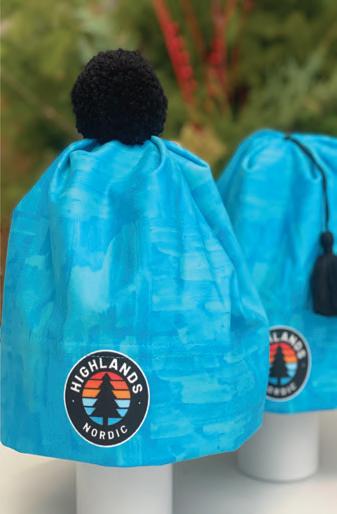












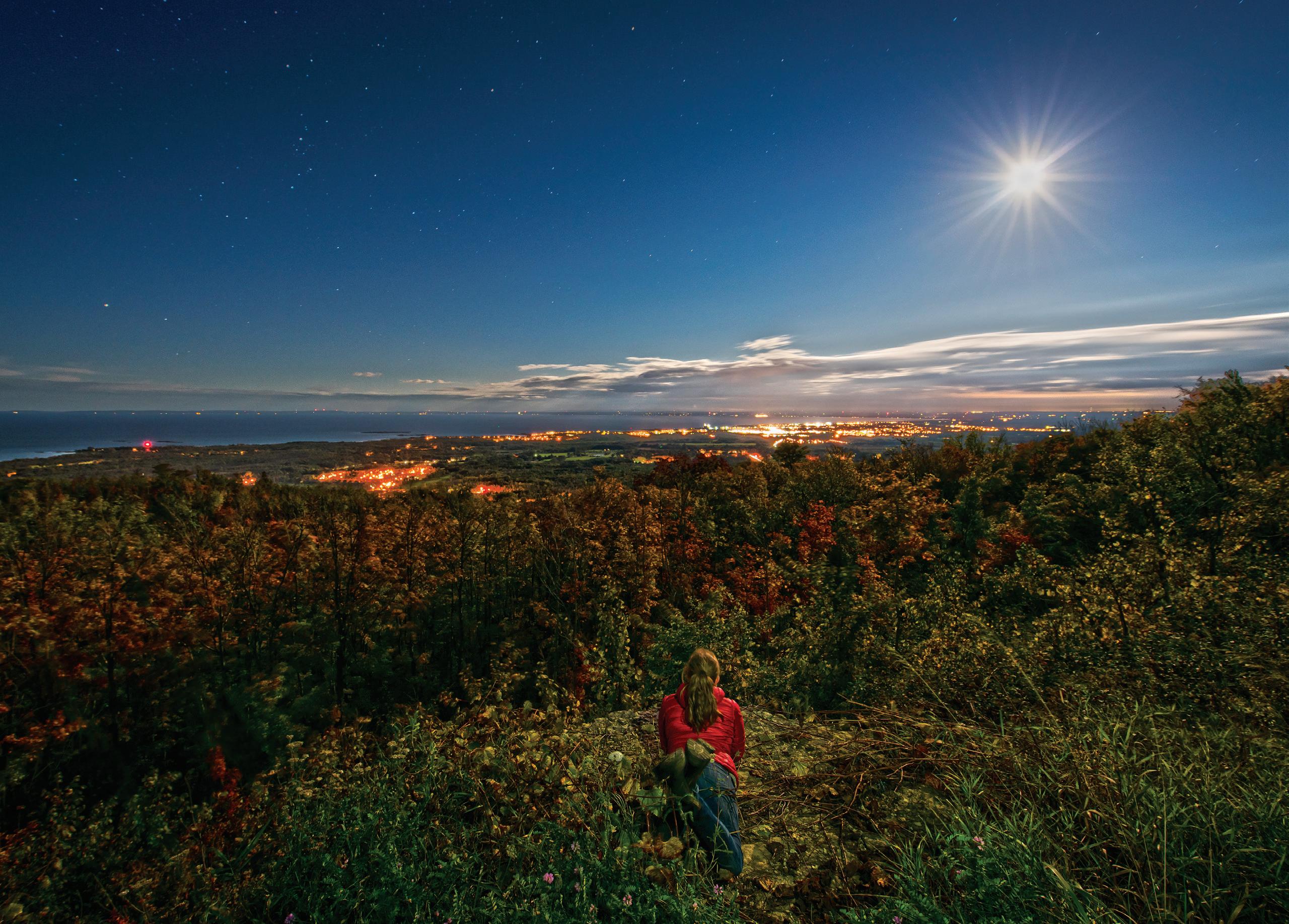
multiple ways to experience leaf peeping. Even a stroll through the village feels different this time of year: shop windows strung with lights, the scent of mulled cider drifting through the air, and patios packed with friends enjoying the last warm glow before the sun slips behind the Escarpment. For some, this is as essential as the view—the food, the music, the chance to take it all in, together.
That togetherness is what draws groups, too. Corporate retreats, wedding parties, and international visitors are discovering what locals have always known: that the Escarpment in autumn is unmatched. “It’s always fascinating to see how far people will travel to experience the colours here at Blue Mountain,” says Jennifer Cummings, Manager of Hospitality Marketing at Blue Mountain Resort. “Each fall, we meet guests from all over the world who come to take in the views. What’s even better is seeing how they make the most of their visit, from riding the gondola to exploring the trails, enjoying the village, or just taking time to relax at the spa. There’s something really special about sharing this season with people experiencing it for the very first time.”
It’s true, fall here is not only about spectacle. It’s also about intimacy: the quiet crunch of leaves underfoot, the chance encounter with a neighbour on the trail, the simple act of looking
up in amazement. Ask anyone who lives nearby and they’ll tell you their favourite vantage point at which to take it all in, often with a wink and a nudge, as though they’re sharing a secret. And in a way, they are.
The best advice? Don’t rush it. Leaves begin to turn in early October, with peak colour arriving mid to late October depending on the year. That unpredictability is part of the charm. Come for a weekend, stay for a few days, and let the season reveal itself. Some years, the maples light up just in time for Thanksgiving. Other years, the show lingers toward the end of the month. Either way, there’s always a golden hour—sometimes an evening at the summit, sometimes an entire week—when everything aligns and the Escarpment feels like it belongs only to you.
Because that’s the thing about autumn here—whether you’re a visitor from abroad, a GTA day-tripper, or someone who knows every turn of the Bruce Trail, the experience levels the playing field. Stand at the summit of Blue on a bright October afternoon, and you’ll hear conversations in half a dozen languages, but everyone is looking out at the same view, eyes wide, caught in the same awe. The Escarpment, in its annual illumination, makes locals of us all. E






Scattered across the countryside, heritage cemeteries preserve the stories of early settlers and communities—quiet landmarks that connect us to the lives, struggles, and resilience of those who came before.
By Cara Williams | Photography by Clay Dolan


YOU DON’T HAVE TO LOOK FAR to find history written into the landscape. Drive the backroads of Simcoe, Grey, and Bruce counties and you’ll come across them without warning: a few moss-covered stones behind a fence, a limestone wall half-hidden in the trees, a wrought-iron gate opening into a patch of quiet ground. These small cemeteries are easy to overlook, yet they carry the weight of history. Some are tied to churches that have long disappeared, others to families whose names still echo in nearby towns. Each one is a reminder that the past lingers quietly in the landscape, holding stories of the settlers, pioneers, and communities that once thrived here.
The Town of The Blue Mountains maintains seven heritage cemeteries. In Banks, the Banks United Cemetery—originally Knox Presbyterian—dates back to 1865. Once tied to several
different Presbyterian charges before joining the United Church in 1925 and later the Beaver Valley charge, it still holds a scattering of limestone markers worn smooth by time. The church is long gone, but the stones reveal fragments of the lives of farming families who built this community—names, dates, and the occasional epitaph that hint at both hardship and hope.
In Heathcote, the Presbyterian Cemetery was established in or before 1872, while Gibraltar holds two heritage sites: the Presbyterian Cemetery, founded in 1880 on land given by John and Jane Cooper, and the Carmel Methodist Cemetery, established in 1870 on land donated by Charles Hogg. Near Victoria Corners, the Anglican Heritage Cemetery was established in the early 1860s and is still cared for today by local residents.
Whites Methodist Cemetery, believed to be the first in the former Township of Collingwood, dates to around 1849–1850,













on land purchased from Samuel White for five shillings. Later, its monuments were gathered into a central location for preservation. The Primitive Methodist Cemetery, established in 1862 on land donated by William and Martha Corley, still stands along the 10th Line near Red Wing and is maintained today by local caretakers.
Just west of Blue Mountain, near Ravenna, another modest graveyard tells a quieter story. Once serving local Methodist and Congregationalist families, its weathersoftened stones stand as a reminder of the small rural congregations that dotted the countryside. Though records are scarce, the site reflects a time when church, farm, and family life were deeply intertwined.
In Priceville, the Old Durham Road Black Pioneer Cemetery stands as a memorial to one of Ontario’s earliest Black settlements, established in the late 1840s and early 1850s by formerly enslaved people and free Black settlers. At its peak, nearly every 50-acre lot along this stretch of road was occupied by a Black family, many arriving via the Underground Railroad or in search of opportunity in Upper Canada. By the 1930s the cemetery had been ploughed under, its stones removed or repurposed. The site might have been lost entirely if not for restoration efforts beginning in the 1980s. Four surviving headstones were recovered in 1990, and a granite monument was unveiled that
Cemeteries are places of history, but they are also places of rest. If you decide to visit one of the sites mentioned in this story—or any burial ground—keep these tips in mind:
• Be respectful of the site and surroundings: Speak quietly, avoid disturbing wildlife, and treat all stones, fences, and gates with care.
• Stay on marked paths or mown areas: Avoid walking directly on graves where possible.
• Don’t touch or lean on headstones: Many are fragile and can be damaged by even gentle contact.
• Leave everything as you found it: This includes flowers, stones, or personal items left by families.
• Photography is welcome—but discreet: Capture the atmosphere without intruding on private moments if others are visiting.
• Check local bylaws: Some cemeteries have visiting hours or restrictions.
A thoughtful visit not only honours those buried there—it helps preserve these sites for future generations to discover and remember.

We’ve raised over $10 million dollars, but we still need your help.
The Georgian Triangle Humane Society (GTHS) has officially broken ground on the David & Helen Capin Regional Centre for Pets & People (RCPP). This vital new facility will shelter more animals, support more families in crisis, and meet the growing needs of the South Georgian Bay and beyond.
This state-of-the-art centre is more than just a building. It’s a promise to the thousands of pets and people who depend on us every year.
Every gift brings us closer to opening the doors of this life-changing space. With your help, we can ensure that pets and people across our region have the care, compassion, and support they deserve.
Naming opportunities are still available. For more information about leaving a legacy and donating, please contact:
Erin Tuckey | CAMPAIGN MANAGER erin.tuckey@gths.ca | 705-445-5204 ex 236
Kayla van Zon | FUNDRAISING CONSULTANT kvanzon@interkom.ca




same year. More recently, a pavilion was built to safeguard the memorial and symbolize safe passage for those who fled slavery. Ground-penetrating radar has confirmed as many as 80 graves beneath the soil. Today, the cemetery is protected by Heritage Grey Highlands.
Other sites echo similar histories. The Petherton Pioneer Baptist Cemetery dates to around 1860, established beside a log Baptist church. When the church closed in the 1890s, the cemetery fell into neglect, only to be restored in 1977 by descendants who gathered surviving stones into a cairn marked with a plaque. In Midhurst, the Pioneer Cemetery contains some of the township’s earliest burials. The names on its headstones still appear on local streets and landmarks, linking the present to its earliest settlers.
For those tracing family history, the Ontario Genealogical Society maintains searchable databases of cemetery transcriptions, photographs, and maps. Municipal heritage committees and local museums preserve burial records, while in Bruce County, the Bruce County Museum offers a cemetery locator tool, and Grey County Archives holds maps and registers for many pioneer plots.
Whether large or small, restored or nearly forgotten, these heritage
cemeteries are part of our shared landscape and history. They tell of immigration and settlement, of perseverance, and of communities that have evolved—or disappeared—over the centuries. The next time you find yourself on a winding back road and glimpse one, slow down. Look closer. Imagine the lives behind the names. Every weathered stone is a chapter in the story of this place, quietly waiting to be read. E







GRAVEL DRIVEWAYS
CULVERT INSTALLATION
RECONDITIONING
GRAVEL DRIVEWAYS
SPECIALTY GRADING AND EXCAVATING
NATURAL STONEWORK
HORSE PADDOCKS
RETAINING WALLS
NEW PARKING AREAS
DITCHING

During the Second World War, Collingwood’s Clyde Aircraft plant helped build one of the fastest bombers in the sky—and in the process, laid the foundations for a neighbourhood that still stands today.


“ITsays here that Russel is finally back from sick leave,” the man said from his seat at the dinner table. His wife, busy carrying food from the stove, gave an indistinct “hmm” in return. As her husband continued to rustle through the newsletter, the children began slapping each other under the table. “It also says that Norm had some tire trouble while on holiday, and that I need to ask Joe to tell me about a duck.” At that, even the boys looked up. Their dad gave them a wink and a shrug. “You know I don’t like you reading that at the table, dear,” his wife said as she laid out the roast. “Clyde Aircraft may help us pay for this lovely new house, but you don’t have to bring them to dinner. Hand it over.” The husband surrendered the company newsletter and ruffled the hair of his youngest. “Yes, ma’am,” he said with a mischievous smile. But she didn’t hear him, as she was herself lost in the pages. “Well, will
you look at that—Farrel Ross’ sister was presented to the Queen,” she said, standing by her husband, paper still in hand. “Mom, no reading at the table!” came the cry from the children. “Boys, don’t disrespect your mother,” came the chuckled reply.
It is, or could be, a typical early summer evening in 1945. And the family is, or could be, any one of hundreds here in Collingwood who found work through the war in Collingwood’s secondbiggest employer—Clyde Aircraft Manufacturing. This landmark business opened in Collingwood during the Second World War, producing much-needed parts for the war effort. Clyde was a modern engineering and machine shop, including a toolmaking department, cafeteria, and fully equipped first-aid clinic supervised by a registered nurse. It was so large that it also published a regular newsletter for its employees and boasted both a men’s baseball team and a women’s softball team known respectively as... well, that’s


Living in the Georgian Bay area, we’re privileged to have nature’s playground right outside our doors.
Whether you’re out exploring or just enjoying the views, you can rely on Darryn, Andrew, and the team at Stroud & Scott Wealth Management to keep your wealth plan on track so you can make the most of the outdoors all year long.
Stroud & Scott Wealth Management is a proud member of the Collingwood, Thornbury, and Blue Mountain communities. We provide custom wealth solutions for families and business owners to help you build your net worth, be tax efficient, protect what matters, and build your legacy.
40 Huron Street, Suite 201 Collingwood, Ontario L9Y 1C5


Andrew Scott Investment Advisor T: 705-444-1524 andrew.scott@td.com
Jeanine Rayner
Client Relationship Associate T: 705-444-5828
jeanine.rayner@td.com
Darryn Stroud, CIM® Senior Portfolio Manager T: 705-444-1904
darryn.stroud@td.com
Natasha McEachern
Client Service Associate T: 705-444-1337 natasha.mceachern@td.com
Sarah Pryce
Client Service Associate T: 705-444-6902
sarah.pryce@td.com

a story for another day. On this day let’s stick with the business side of things. And this business was “an invaluable asset to our industrial side,” as a local paper raved.
And an invaluable asset to Canada’s war effort too. While the Collingwood Shipyards was busy producing trawlers and corvettes on the other side of the harbour, Clyde Aircraft employed over 500 people to work in its 65,000-square-foot factory, where they were busy manufacturing a wide range of parts and materials for tanks, army and navy guns, and aircraft—including canopy tops, fuel oil, and hydraulic pipes. All of those aircraft parts (for which the company, of course, bore its name) were destined for the infamous Mosquito Bomber.
The de Havilland DH.98 Mosquito (nicknamed the “Wooden
Wonder” or “Mossie”) was constructed mostly of wood. And while many at the time thought that was crazy, for this very reason it was one of the fastest operational aircraft in the world for most of the war period, with a top speed of 415 mph. That was over 100 mph faster than any fighter in the sky. Originally conceived as an unarmed fast bomber with a payload as large as the B-17, the Mosquito’s use evolved during the war into many roles, including low-to-medium altitude daytime tactical bomber, high-altitude night bomber, pathfinder, day or night fighter, fighter-bomber, intruder, maritime strike, and photo-reconnaissance aircraft. It was also used as a fast transport for high-value cargo to and from neutral countries through enemy-controlled airspace. The Mosquito could do everything—and very well.










Proudly located in one of Collingwood’s most sought-after neighbourhoods, Victoria Annex is coming to life. Construction is well underway at 400 Maple Street, where a transformed 19th-century schoolhouse and an inspired new coach house are nestled among luxury single and semi-detached homes that pay homage to Collingwood’s rich history and charm. Limited to just nineteen homes and steps from the downtown core, a remarkable lifestyle awaits.

The site has had many uses through Collingwood’s history, both before and after Clyde Aircraft’s operation in the 1940s.
The Imperial Steel and Wire Co. operated on the Harbour Street site from 1904 until 1919 when the main building and adjacent structures were struck by a devastating fire. The fire was attributed to oil residue on the wood floors and spontaneous combustion. The factory was rebuilt between 1919 and 1921, and the plant enjoyed a short operation until 1925. The facility was later re-opened as the Huronia Wire Company after a lengthy closure. On August 15, 1940, an agreement was reached with Clyde Aircraft for the sale and purchase of the premises for use during the Second World War.
At the end of Second World War, Globe Plywoods Limited converted the Clyde Aircraft plant to build “knockdown” furniture for Great Britain. This style of ready-to-assemble furniture was easily shipped and required little storage space. When the company began operations, twenty percent of its workforce was composed of veterans. A.R. Kaufman of Kitchener provided capital for this new industry, and the rest is history.
Globe Plywoods Limited became Kaufman Furniture and remained an important Collingwood industry until its closure in 2005. In its early years, Kaufman produced lower-priced furniture. In the 1960s, its direction shifted to compete with American imports. A leather upholstery department was introduced, and furniture designs were upgraded for a higher price point. Both the factory and iconic smokestack were demolished in 2008. Today, the site remains vacant along Highway 26.
An interpretive panel along Balsam Street on the Collingwood Trails speaks to the history of the property.


Enjoy responsibly

SCAN FOR RECIPES


Ten different variations of that Mosquito Bomber were made right here in Canada. More than 1,000 planes by the end of the war (and even a couple after the war ended). It all happened at the Downsview Airfield with parts gathered from places like Collingwood.
Clyde Aircraft employed so many people that the resulting influx of workers created a housing boom, and the little part of our town that became Victory Village was born. It came to be through the efforts of the federal crown corporation Wartime Housing Limited. Through the early 1940s, 100 homes were slated for construction between Hurontario and Birch Streets on Seventh, Eighth, and Ninth Streets. At the time of construction, the homes

Clockwise from top left: Victory Village home of Grant Temple on Hurontario Street South in 1943. Collingwood Museum Collection, X970.929.1; Huron Institute No. 2880. The Imperial Wire and Steel Co. along Balsam Street in 1921. Collingwood Museum Collection, X972.43.1; Huron Institute No. 748. “Marge” Spencer at work inside the Clyde Aircraft facility, 1941. Collingwood Museum Collection, 003.89.2.
sold for anywhere between \$1,800 and \$2,300.
And here is where history turns an interesting full circle. After the war, the facility was retooled to make flat-pack bedroom suites under the name Globe Plywoods Limited. Not too long after that it was renamed Kaufman Furniture. Kaufman shipped its quality tables and chairs across North America and manufactured highend furniture for numerous North American hotel chains. How many of the homes built in part by Clyde Aircraft were also then furnished with the peacetime products of Globe and Kaufman?
The Kaufman factory closed in 2005 and was finally demolished in 2008, but Victory Village—the houses that the Mosquito Bomber built—are still here today. E












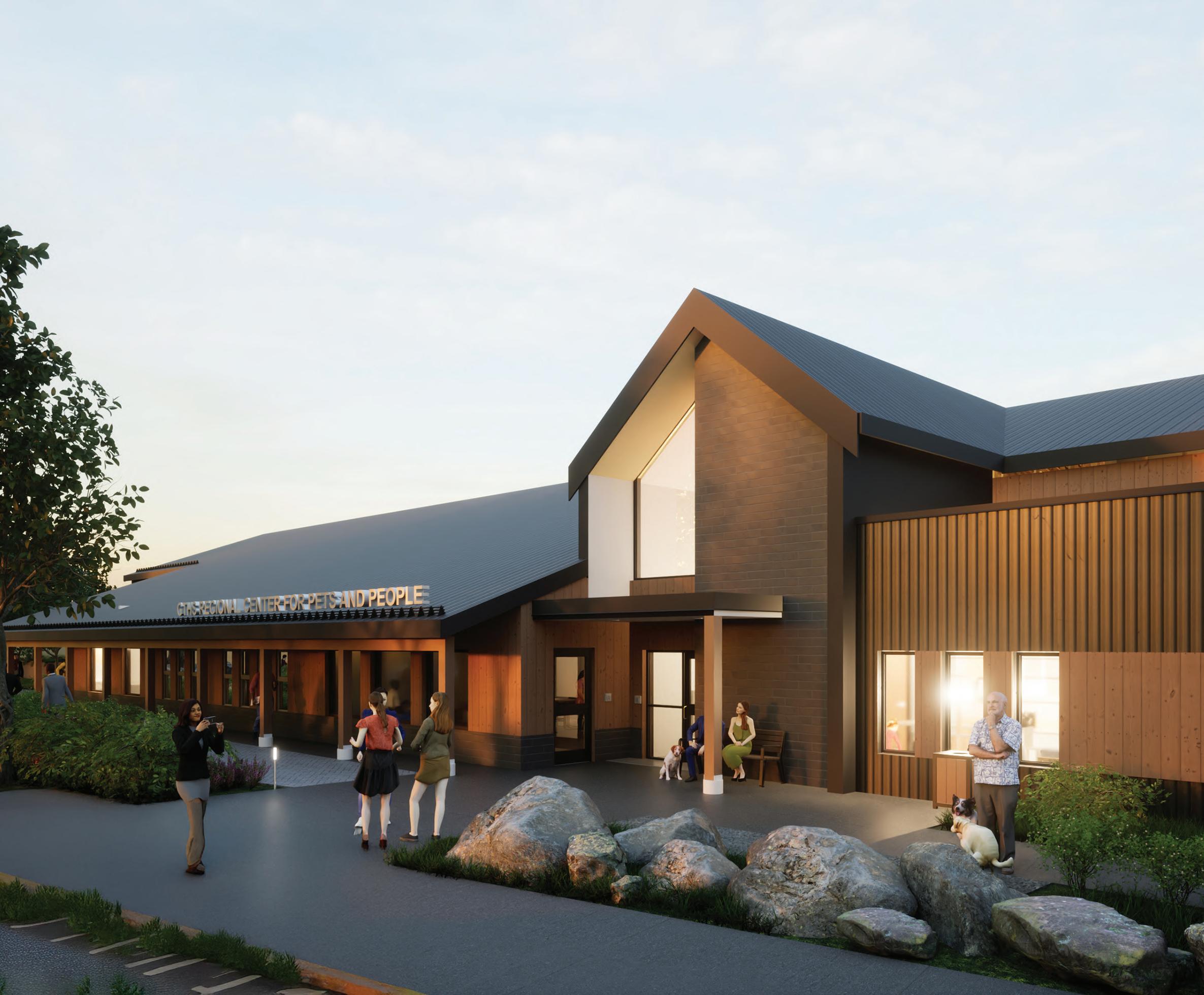
By Kayla van Zon | Photography by Danielle White

The Georgian Triangle Humane Society (GTHS) has officially broken ground on the David & Helen Capin Regional Centre for Pets and People (RCPP)—a transformative new facility designed to meet the urgent and growing needs of pets, families, and the wider South Georgian Bay community.
For years, the GTHS Animal Centre on Tenth Line has been stretched to its limits. Overcrowded kennels, overbooked surgeries, and an ever-increasing demand for programs and services have underscored a reality many in the community already know: the need has outgrown the space.
On September 18, 2025, the GTHS celebrated not only the start of construction on its long-awaited new home, but also a milestone achievement of $10.6 million raised toward its $17.6 million campaign goal. This extraordinary progress reflects the generosity of donors, volunteers, and supporters who believe in the vision of a community where pets are safe, families are supported, and the human–animal bond is celebrated.
Yet, as GTHS leaders made clear at the groundbreaking ceremony, the work is not done. Community support remains critical to complete the project and bring the vision to life.
The new David & Helen Capin Regional Centre for Pets & People is not simply a replacement for the current building—it’s a bold reimagining of what a humane society can and should be. Designed
by Unity Design Studio and built by Bertram Construction, the centre will be a functional, welcoming, and sustainable hub that reflects the deep bond between animals and people.
Once complete, the facility will dramatically expand GTHS’s capacity:
• Over 5,500 animals sheltered annually, providing safety, nutrition, and rehabilitation to pets in need.
• More than 6,700 spay and neuter surgeries each year, preventing suffering and reducing overpopulation across the region.
• Support for 2,200+ people in crisis, offering stability and resources during their most difficult moments.
• Engagement of more than 6,000 youth annually through hands-on, compassionate learning programmes that build empathy and responsibility.
• 30,000 annual visitors welcomed, ensuring pets find loving homes faster than ever before.
• 600 volunteers and 50 staff supported with the space and resources to provide the highest standards of care.
“These numbers aren’t just statistics,” explains Karen Marsh, Executive Director of GTHS. “They represent real animals, real families, and real stories of transformation. The new centre will allow us to do more than ever before—to meet people where they are, to provide urgent care, and to ensure no pet is left behind.”
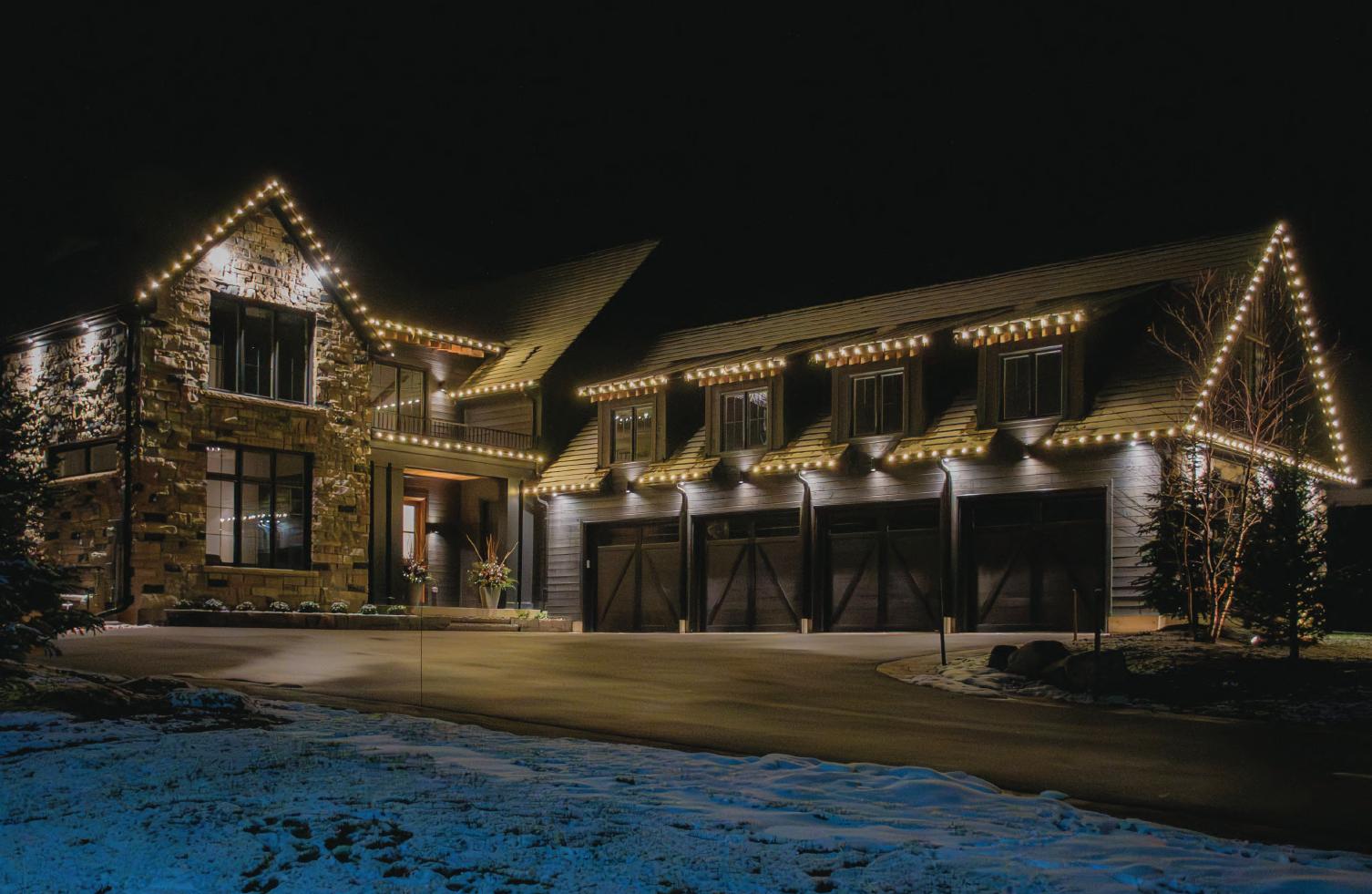




At the heart of this project is a community united by compassion. Among the many generous contributions, a significant philanthropic gift from Monika Merz and her husband, Michael T. Miller, has named the Animal Hospital & Wellness Centre within the RCPP.
“This centre has always been about heart, compassion, and community,” says Merz, who also serves as Chair of the GTHS Board of Directors. “We are proud to support this vital project, knowing it will provide urgent medical care and expand programs like spay and neuter, which are essential to long-term solutions. Our hope is that this hospital will become a cornerstone of compassion for generations to come.”
Their gift is one of many that have propelled the campaign to its current $10.6 million total. But with $7 million still to raise, GTHS is calling on individuals, families, and businesses across the region to step forward.
South Georgian Bay is one of the fastest-growing regions in Ontario. With population growth comes increased pressure on families, more economic challenges, and, inevitably, more pets in need of care.
The current GTHS Animal Centre was never designed to meet

today’s demand. It is consistently at or over capacity, with limited space for animals, staff, and volunteers. Essential programmes such as affordable spay/neuter services, humane education, and crisis support are in high demand—but constrained by infrastructure.
The new Regional Centre for Pets & People is designed to directly address these issues. It will be a hub for animal welfare and human wellness, ensuring pets are not only sheltered but given the chance to thrive, and families in crisis are not left without support.
“This is more than four walls and a roof,” says Marsh. “This is about building hope, stability, and a better future for pets and people alike.”
The groundbreaking is just the beginning. To complete construction and open the doors of the new centre, GTHS needs the continued support of its community. Every gift—large or small—makes a difference.
Donors can make their contributions online at supportgths.ca, or by connecting directly with the fundraising team. E
For those interested in major gifts, legacy giving, or community partnerships, please contact:
Kayla van Zon, Fundraising Consultant, kvanzon@interkom.ca
Erin Tuckey, Campaign Manager, erin.tuckey@gths.ca










“AN EXPERIENCE THAT FEELS SPECIAL ”

FOR THE SUPPORT OF THIS COMMUNITY AND PROUD TO CAL L GUSTAV A PLAC E WHERE FRIENDS AND FAMILY GATHER. WE LOOK FORWARD T O MANY MOR E YEARS OF SHARING GREAT FOOD, GREAT WINE, AND GREAT MEMORIE S TOGETHER. ”



-JOHN GARBE, OWNE R
for over 10 years, we’ve been serving up chophouse favourites in collingwood — and we’d love for you to come as you are and enjoy! whether it’s a relaxed brunch, a night out with friends, one of our delicious weekly specials, or a tasting with our wine club, there’s always something to enjoy at gustav chophouse & bar.

weekly specials -
happy hour
$6 mimosas
$6 beer, wine & bar rail and food specials, daily from 3pm - 6pm daily from 9am - 2pm
wine wednesday oyster thursday
enjoy all 5oz and 9oz wine pours at 50% off (excluding house red & white).
$2 oysters and $34 oyster caesar flights from 5pm until supplies last. reserve your table at gustavs.ca




Can you feel the momentum building? Tomorrow’s Hospital is coming to South Georgian Bay and will redefine what healthcare means for generations to come.
This year’s Tree of Life Campaign embraces the anticipation for the new hospital as we come together to raise over $100+ million.
Set on a greenfield site, the new hospital will be a bright, modern space built around compassion, excellence, and innovation. Every patient will have a private room designed to support healing, surrounded by the comfort of family and the highest standard of care.
Tomorrow’s Hospital will expand healthcare services for our fast-growing community, improve patient care and privacy, attract top healthcare professionals, and build on our strengths in education and training. With your help, the new facility will be ready to support all of us when we need it most.
Building tomorrow, together. Join the $100+ million campaign for the new hospital.



From his start at George Brown College to cooking for Queen Elizabeth II, Chef Jesse Bell’s career has taken him from the Canadian Rockies to Toronto’s Fairmont Royal York and beyond.
Today, as Executive Chef at Gustav Chophouse and Bar, Jesse draws on his wealth of experience to craft dishes that balance refinement with comfort. For this collection, he shares three house favourites—each a showcase of seasonal flavour, elevated technique, and approachable indulgence.

Slow-braised until the meat falls from the bone, this dish layers red wine, fresh herbs, and beef stock into a deeply savoury sauce. Elegant enough for entertaining yet soulful enough for Sunday dinner. Serves 4
INGREDIENTS
4 lamb shanks (400–500 g each)
1 lb carrots, chopped
3 stalks celery
2 medium Spanish onions
4 garlic cloves, smashed
500 ml dry red wine (Cabernet
Sauvignon, Merlot, or Syrah)
5 bay leaves
10 whole peppercorns
½ cup all-purpose flour (for dredging)
1 can (156 ml) tomato paste
10 sprigs fresh thyme
3 sprigs fresh rosemary
4 L beef stock
Salt & pepper to taste
100 ml canola oil
METHOD
Prep & sear: Preheat oven to 325°F (163°C).
Season lamb, dredge lightly in flour, and
sear in hot oil until golden. Remove.
Sauté vegetables: In same pot, cook carrots, celery, and onions until softened (10 minutes). Add garlic and tomato paste; cook 5 minutes.
Deglaze: Add red wine, scraping up browned bits. Simmer 2 minutes.
Braise: Return lamb to pot with bay leaves, peppercorns, thyme, and rosemary. Add enough stock to cover. Cover and transfer to oven. Cook 4 hours, until tender.
Finish sauce: Strain liquid into a saucepan, reduce to sauce consistency, and season. Serve: Spoon over creamy mashed potatoes or polenta.











DRINK PAIRING
Collingwood Double Barreled Old Fashioned
2 oz Collingwood Double Barreled
0.25 oz pure maple syrup
2 dashes Angostura bitters
Orange peel garnish
The bold caramel and oak notes of Collingwood Double Barreled mirror the richness of the lamb, while maple syrup in the cocktail nods back to Ontario terroir.
A Gustav signature dish. This velvety soup brings together roasted butternut squash, fragrant thyme, and pure maple syrup,
finished with a swirl of cream. A comforting starter that feels both rustic and elegant— perfect for chilly days. Serves 4
INGREDIENTS
4 lbs (approx. 2 medium) butternut squash
2 medium Spanish onions, chopped
1 lb carrots, chopped
6 stalks celery, finely diced
4 whole garlic cloves
2 L vegetable stock
250 ml 35% cream
125 ml pure maple syrup
6 sprigs fresh thyme
Salt & pepper to taste
100 ml canola oil (divided)
METHOD
Roast the squash: Preheat oven to 425°F (220°C). Peel, seed, and chop squash. Toss with 50 ml canola oil, salt, and pepper. Roast on a parchment-lined tray until tender and caramelized (25 minutes). Cool slightly.
Sauté vegetables: In a large pot, heat remaining oil. Add carrots, celery, onions, thyme, and garlic. Cook 10–15 minutes until softened.
Simmer: Add roasted squash and stock. Bring to a boil, reduce heat, and simmer 25 minutes.
Blend & finish: Purée until smooth. Stir in cream, maple syrup, and adjust seasoning. Thin with stock if needed.
Serve: Ladle into bowls, drizzle with cream, and garnish with thyme leaves.







A timeless comfort classic. Moist sponge made with dates, served warm with toffee sauce and a scoop of vanilla ice cream— pure indulgence. Serves 4
INGREDIENTS
8 oz dates, pitted and chopped
¾ cup water
1 tsp baking soda
5 tsp salted butter, softened
⅓ cup brown sugar (just under)
2 eggs
1 tsp vanilla extract
1¼ cups all-purpose flour
Toffee Sauce
½ cup salted butter
½ cup brown sugar
½ cup 35% cream
1 tbsp molasses
Pinch of salt
½ tsp vanilla extract
METHOD
Preheat & prep: 350°F (175°C). Grease ramekins or baking dish.
Date mixture: Simmer dates in water until soft (5 minutes). Stir in baking soda, cool.
Batter: Cream butter and sugar. Beat in eggs and vanilla, then fold in cooled date

mixture and flour.
Bake: 25–30 minutes, until tester comes out clean.
Toffee sauce: Simmer butter, sugar, cream, and molasses until thickened (5–7 minutes). Stir in vanilla and salt.
Serve: Warm pudding topped with sauce and vanilla ice cream.
PAIRING
Collingwood Chai Toddy
200 ml strong chai tea
1.5 oz Collingwood Black 1 oz vanilla simple syrup*
0.5 oz fresh lemon juice
Cinnamon stick garnish
Vanilla Simple Syrup: Simmer equal parts sugar and water with a few drops of vanilla extract until dissolved.
The spiced warmth of chai, layered with Collingwood Black whisky, enhances the deep caramel richness of the toffee pudding—comfort in a cup. E






Our Personalized Medical Programs Include
689 10th St W Unit 2, Owen Sound (519) 371-1111 waterdepotowensound
707 River Road West, Wasaga Beach (705) 422-1938 waterdepotwasaga
•In-person and virtual consultations which are available to ensure our clients get the best care, no matter where they are located
•Live in a remote area or travel a lot? Book a virtual consultation via telemedicine
•Full hormone assessment with a Medical Doctor and/or Nurse Practitioner
•Comprehensive lab testing - blood/serum
•We o er all hormones including HCG, DHEA & Human Growth Hormone
Specializing in Bioidentical Hormone Replacement Therapy (BHRT) for Men & Women. Our integrative approach incorporates the latest in medical and evidence-based treatment with a BHRT medical specialist to obtain optimum results. We help our clients get the best out of life by optimizing their health & performance, preventing disease, and slowing the biological aging process. Our comprehensive approach enables us to detect, prevent, treat, and even reverse some disease. Specialty Programs
•Hormone Optimization
•Thyroid Balancing
•Lyme Disease Treatment
•Trauma Brain Injury - Concussions
•PTSD
•PCOS - Polycystic Ovary Syndrome
•Menopause (women)
•Andropause (men)

Telephone: 647.884.0663 (text or call) Email: donna@trubalancehealthcare.com




Canada’s Leading Medical Network for (Human Identical) - Bioidentical Hormone Replacement Therapy

Our Network is Across Canada, All Provinces + the Yukon - with Direct Referral to a Clinic - www.trubalancehealthcare.com Our BHRT Prescribing CME Accredited Education in Toronto is
Walk into any pharmacy, health food store, or even scroll through your social media feed, and you’ll be met with an array of nutritional supplements. From brightly packaged bottles promising more energy, sharper focus, or better sleep, it can be difficult to separate marketing from genuine health support. The truth is, supplements can play an important role in filling nutrient gaps and supporting specific conditions, but not all products are created equal—and not every supplement is necessary.

Dr. Shelby Worts, BSc, ND
Some types of magnesium, for example, are better for easing constipation (oxide or citrate), while others absorb better and address your body’s needs (glycinate, malate). B12 is another example: cyanocobalamin is synthetically produced, while methylcobalamin is naturally found in foods and is more supportive of cardiovascular and nerve function. Iron can cause constipation and gut discomfort, particularly the type ferrous sulphate, while other forms are more gut-friendly. In practice, I have seen several people experience loose stool from a popular bone health formula sold online; the label shows the product contains the cheaper magnesium oxide rather than a more well-absorbed form. It may seem like a small detail, but it makes a difference.
Does the product provide the correct therapeutic dose? For example, the product may contain ingredients with certain health claims, but are these included at a sufficient therapeutic
level? Is the dose at least equal to that found in the clinical studies? This question is particularly relevant when product labels list ingredients under a “proprietary blend,” containing a collection of beneficial compounds, but with no indication of their individual amounts.
Finally, do you actually need it? Traditional ads and social media influencers can make a product sound overwhelmingly appealing, but keep in mind these are both forms of advertising—people are paid to promote products to you. Wouldn’t it be better to explore the cause of your symptoms? For example, do you really need an energy-boosting pill, or do you simply need better quality sleep? Do you need a digestive aid with each meal, or should you explore chewing your food more thoroughly or learning if you have some undiagnosed food sensitivities? Is the sleep supplement the answer to your problems, or do you need to work on stress management and adjust your bedtime habits?
Remember, if a product sounds too good to be true, it likely is—there are no “magic bullets” out there. Work with a qualified healthcare provider—such as a naturopathic doctor—who can order tests, take a thorough history of your symptoms and health, and create an individualized plan, which may include supplements that will be of benefit to you (and won’t interfere with your medications). E


At Quaintrelle, we don’t just offer services—we provide an experience that transcends traditional aesthetics. We know the path to beauty is deeply personal, and it starts with a conversation. That’s why our team is dedicated to understanding your goals, listening to your needs, and collaborating with you to create a treatment plan that feels like a natural extension of yourself. With modern approaches that celebrate your authentic beauty while boosting your confidence, our staff is here to guide you every step of the way.











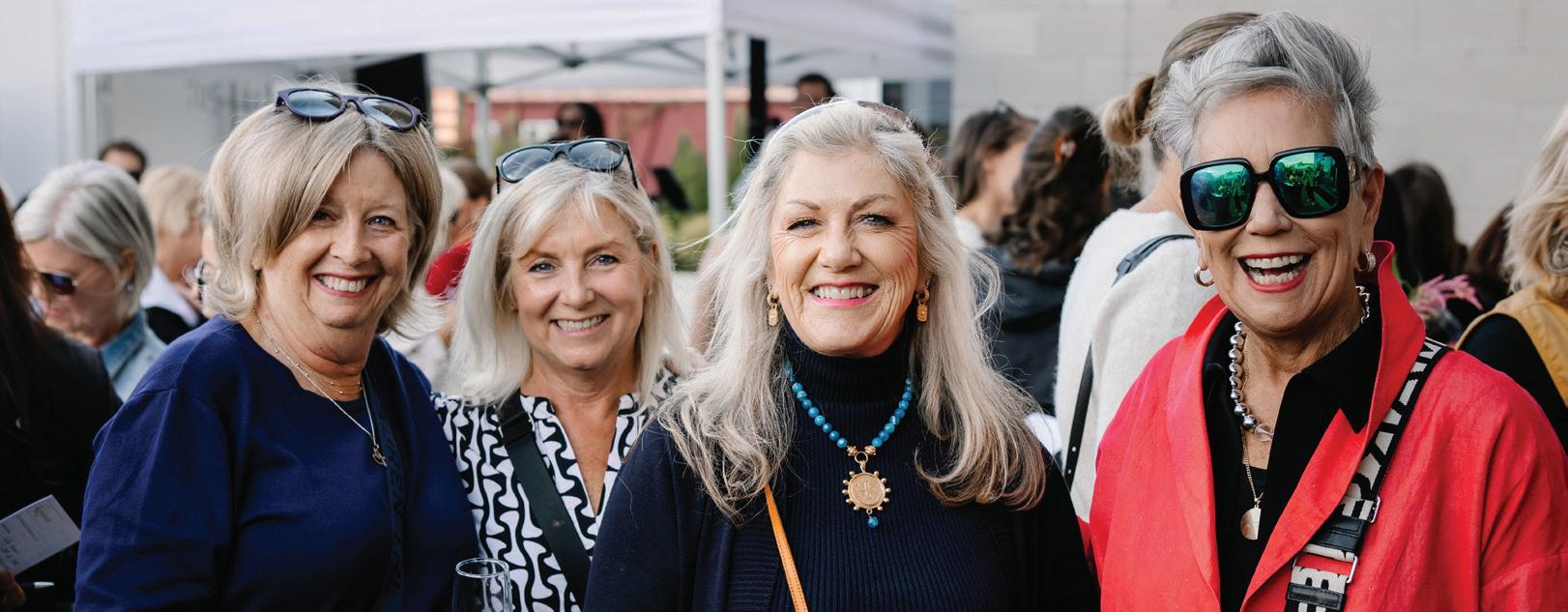
THANK YOU FOR JOINING US AT OUR SEPTEMBER CUSTOMER APPRECIATION EVENT – WE TRULY APPRECIATE YOUR CONTINUED SUPPORT AND ENJOYED CELEBRATING WITH YOU!







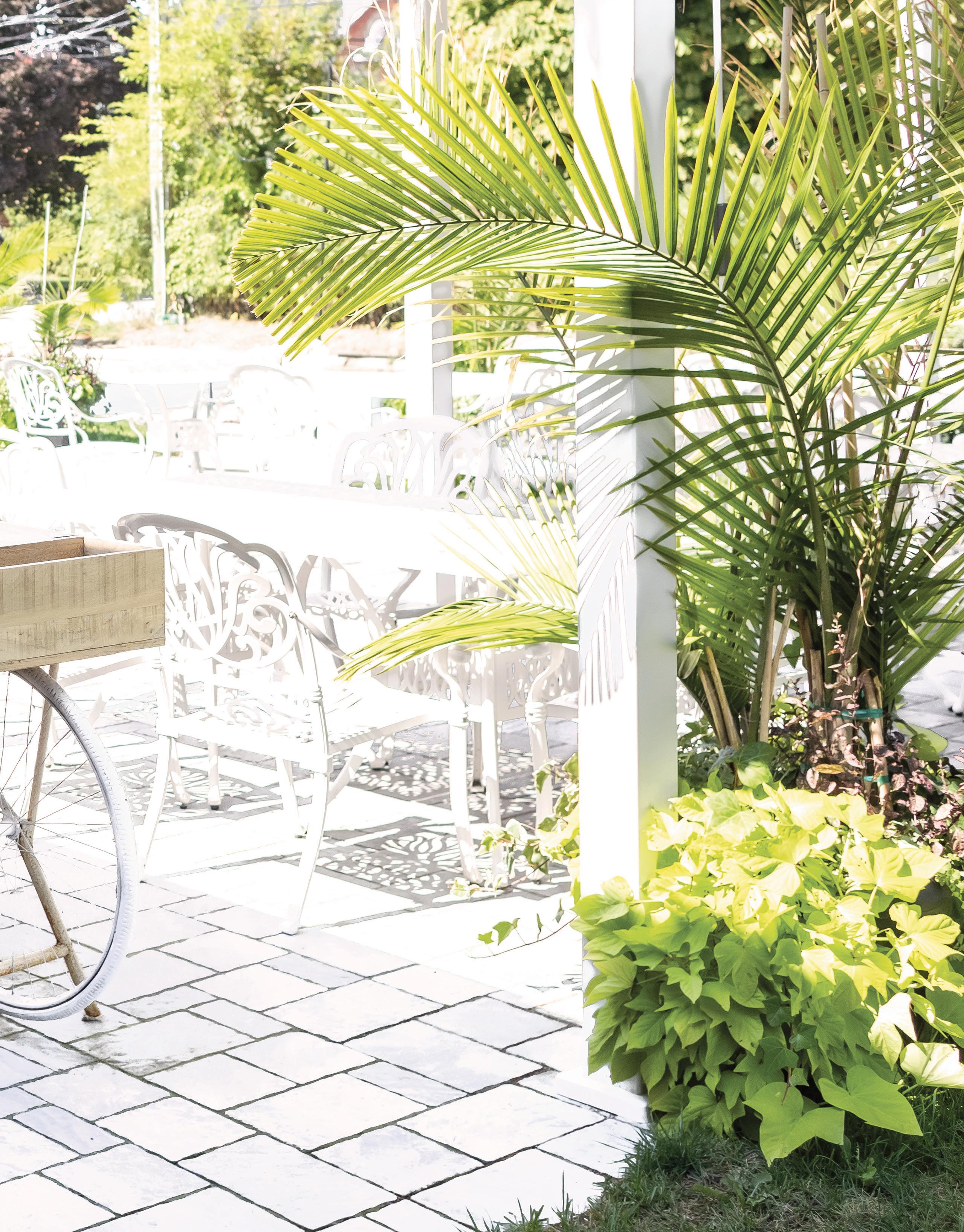
Hair & Makeup by Katie Ballantyne
Shot on location at Katherine’s
Château, Collingwood


shoes

Hitesh finds endless inspiration in Collingwood—whether hiking trails, exploring new places, or dancing to a rhythm. The town’s welcoming community offers him the perfect balance of energy and calm. For him, life is about humanity and spreading peace.
Kiersten thrives on challenge, from Hyrox and Spartan races to triathlons, while also embracing yoga, mindfulness, and meditation. She loves exploring the outdoors in Simcoe County and finding balance between movement and reflection. In her career, she leads partnerships and growth in media and advertising sales across digital platforms.

Dayna is a civil servant and entrepreneur with a passion for wellness. When she’s not balancing her dual roles, you’ll find her at the gym, out in nature, or spending time with family, friends, and fellow entrepreneurs in the local community.

Blair
Known as The Real Estate Angel, Aliza is a trusted professional serving Simcoe County and beyond. A presenter with Making Change and past president of the Wasaga Beach Women’s Business Association, she’s dedicated to connection, empowerment, and community leadership. A proud mother of two, performer, fitness enthusiast, and Formula 1 fan, Aliza brings authenticity and energy to all she does.



















Exploring the dynamic relationship between landscape, memory, and material through gestural abstraction, Shirra Benson creates richly textured oils exploding with emotion, passion, and complex encounters.
By Deena Dolan

ASA CHILD, it was her paternal grandmother who introduced Shirra Benson to the wonders of creating art. It came easily. There was an obvious spark that followed her throughout her school years growing up in Aurora, culminating in her graduation from Georgian College’s Fine Arts program in 2007. Even though she was excelling in producing art and selling pieces, there was a strong, tandem passion competing for her attention: horses. “I was obsessed. For a time, I pursued a career in equestrian show jumping and wanted eventually to become an Olympic show jumper.”
Becoming deeply disenchanted, however, with that world’s physical and ethical concerns, Shirra ultimately rounded up her horse, gathered her cat, and relocated to Collingwood, where she quickly fell under the Escarpment’s spell. Inspired by the rugged beauty and ever-changing moods of Georgian Bay, her joy of painting was ever present and, following what she describes as “the transformative experience of motherhood,” Shirra returned to her craft in a more substantive manner.

Time spent outdoors has always been the fuel driving Shirra’s creativity. Hiking tops the list of favourite activities, followed closely by golf, cycling, cross-country skiing, and simply enjoying the experience of exploring. These moments allow her to filter out the noise and reconnect with the pure rhythms of nature. “My paintings aim to honour the spirit of place and the quiet strength found in nature.” Whether painting on site, en plein air, or by capturing a scene with her camera to be recreated in her studio, Shirra encapsulates the energy, mood, and emotion she feels within the scene and infuses it back onto the canvas.
Working in oils, Shirra humbly describes herself as an emerging artist. As I chatted with her, however, while visiting her home studio
in Owen Sound, my impression of her work invoked a much more advanced suggestion. This woman is a true artist with an expertly developed, original style in combination with strong convictions about the importance of art in our everyday world. “There is a distinct beauty in human-made artwork. Something that computers cannot ever replicate.” Shirra takes pure delight in capturing simple, everyday scenes: familiar places where people have been and can easily identify. “I love being connected to the community.” Local golf courses, farmers’ markets, hiking trails, and ski runs have all been subjects readily purchased by collectors. She also frequently transforms clients’ special places, moments, and memories into


























commissioned pieces.
“Rather than depict the land literally, I respond to it— allowing process, intuition, and physical engagement with the medium to shape each composition. The resulting works suggest layered histories: geological, environmental, and personal. Areas of dense, frenetic mark-making contrast with open fields of calm, echoing the rhythms of the landscape itself.”
Alongside her landscapes, Shirra also creates intensely interesting abstract pieces, exploding with shape, colour, and mood. “My most recent abstract process is unplanned and intuitive in nature, and could never become a computergenerated work of art.” Her ability to move between the realms of actual versus abstract is daunting. “Describing my own artwork is the most challenging part of being an artist… I feel deeply and release my energies onto the canvas. My style is developing and
I am always playing and experimenting. I like to call this paint doodling, if there is such a thing.” With several paintings on the go at the same time, this uninhibited practice of exploration produces works that are both magical and profoundly personal.
“The imagery in my work replicates the elemental structures, forms, and colours I see around me, in passages filled with frenetic activity as well as areas of calm. In every instance, I encourage the viewer to encounter the work from their own perspective, in order to allow for variations in interpretation.”
Driven by a deep reverence for the earth, her canvases evoke emotion, movement, and energy through her use of various techniques including wet-on-wet, impasto, and her dramatic use of sweeping gestures achieved with thick applications of paint.
“Using a highly personal approach to gestural abstraction, my work engages with both the natural environment and historical artifacts











in a textural language that implies elements of both, as channelled through personal experience and the painting process itself.”
Shirra Benson’s work has been exhibited in Owen Sound’s Artist Co-op and throughout surrounding communities, including Meaford, Thornbury, Collingwood, Southampton, and Stratford. Her website, Nádúr Art Studio, is well worth a visit. The Gaelic name was inspired both by Shirra’s background and her spirited focus on the varied aspects of nature.
“Whether inspired by a windswept escarpment, the wide stillness of Georgian Bay, or the slow erosion of a field, each painting invites the viewer to find their own way into it— interpreting form and gesture through the lens of their own experience.” E
For more information please visit: nadurartstudio.com artistscoop.ca





A newly built chalet at the base of the Escarpment balances modern design with timeless alpine tradition. From soaring timber-framed peaks to energy-smart details, this family retreat is as functional as it is beautiful.
By Marc Huminilowycz | Photography by Clay Dolan

What does a successful professional engineer who has skied Blue Mountain for sixty years do upon his retirement? He and his wife build a permanent luxury family chalet at the base of the mountain, of course. And what a chalet it is, rooted in generations of ski weekend retreats.
“We decided that instead of going ultra-modern, we would build a true home that was functional and low-maintenance— not overly traditional or woody, but with a ski feel,” said the homeowner. From the front, the home makes a bold alpine statement, with dramatic peaked roofs framed in hand-hewn timber, and expansive floor-to-vaulted-ceiling windows with arched tops that face directly south over the ski runs.
Upon entering the chalet, the focal point is a great room with high vaulted ceilings, a floor-to-ceiling fireplace, and striking views over the ski slopes. With natural wood floors and ceilings, stone accents, light-coloured rugs and furniture, and modern accessories, the home conveys warmth, style, and character.
Construction of the chalet began in August 2022. The project, at the time, was designed by local architect Andrew Slade. “Andrew’s computer design process made it easy to visualize the look of the home,” said the homeowner. “He presented some good ideas, such as airflow and natural ventilation using strategically placed skylights, gables for sun protection in the summer, the large window with a
view up the ski hills, the great room centrepiece fireplace, neutral floors with colourful area rugs, and carpet runners up the stairs for safety.”
“The traditional elements of the chalet, like its strong gabled roofs, are iconic, but my clients had a preference for a modern aesthetic,” said Andrew Slade. “The homeowners had a great appreciation for modernism, building science and technology, and the kinds of techniques and principles that we use in design to convey a high-tech look with traditional grounding. The main living spaces are situated on the second floor, including a vaulted woodceiling master bedroom that includes a spa-like ensuite and a double glass door opening to a terrace overlooking the ski hill.”
“The Tiltco curtain wall we used in the great room is triplepane glass, which has a high insulation value. Playing with the rooflines, it is part of the home’s energy-saving passive solar design,” Slade added. “The sunlight is controlled for more shade in the summer via large dormer gables to keep the home cool. In the winter, with the sun twenty-two degrees lower in the sky, the great room is flooded with natural light, warming the space as well as the central fireplace which, by virtue of its thermal mass, will store the heat and gradually re-radiate it throughout the day and night. I loved working on this project from day one. Incorporating traditional ideas enhanced by modern elements, we created the warmth and identity of a traditional chalet.”





“INCORPORATING TRADITIONAL IDEAS ENHANCED BY MODERN ELEMENTS, WE CREATED THE WARMTH AND IDENTITY OF A TRADITIONAL CHALET.”


According to Slade, the fireplace was always meant to be the focal point of the great room. “The homeowners gave me a sketch of it in the centre of the home, pretty similar to what we did,” he said. “The hearth is truly the heart of this chalet, going from the foundation up to the cedar ceiling of the second storey, stacked from one floor to the next, creating a central feature that is both functional and beautiful.”
“Building the great room and fireplace presented several challenges and opportunities,” said Steve MacDonald, founder and owner of PattyMac Inc., which has built a reputation for excellence over fifteen years with an impressive portfolio of luxury homes, cottages, vacation homes, and chalets in Muskoka and Southern Georgian Bay.
“The steep angled roof over the great room involved intricate framing because of many inverted hips, and various areas required
cladding to create beams,” MacDonald added. “Getting to the top of the fireplace to slab the entire length and achieve the desired level of finish with that magnitude took a lot of coordinated effort and a lot of scaffolding, but in the end, everyone was pleased with the result.”
MacDonald describes the chalet as a seamless blend of modern and traditional elements. As an example, he describes another focal point of the great room: a semi-circular cantilevered balcony with radius (curved) glass overlooking the room below and the view south over the slopes from the upper living area. “This was a unique feature—a gorgeous piece of craftsmanship that our crew played a role in creating, including a curved, heated, and bent natural wooden railing,” he said. He also points out another unique feature of the home—a mono stringer-design staircase supported by a large steel beam and embellished with wood details and carpet runners to


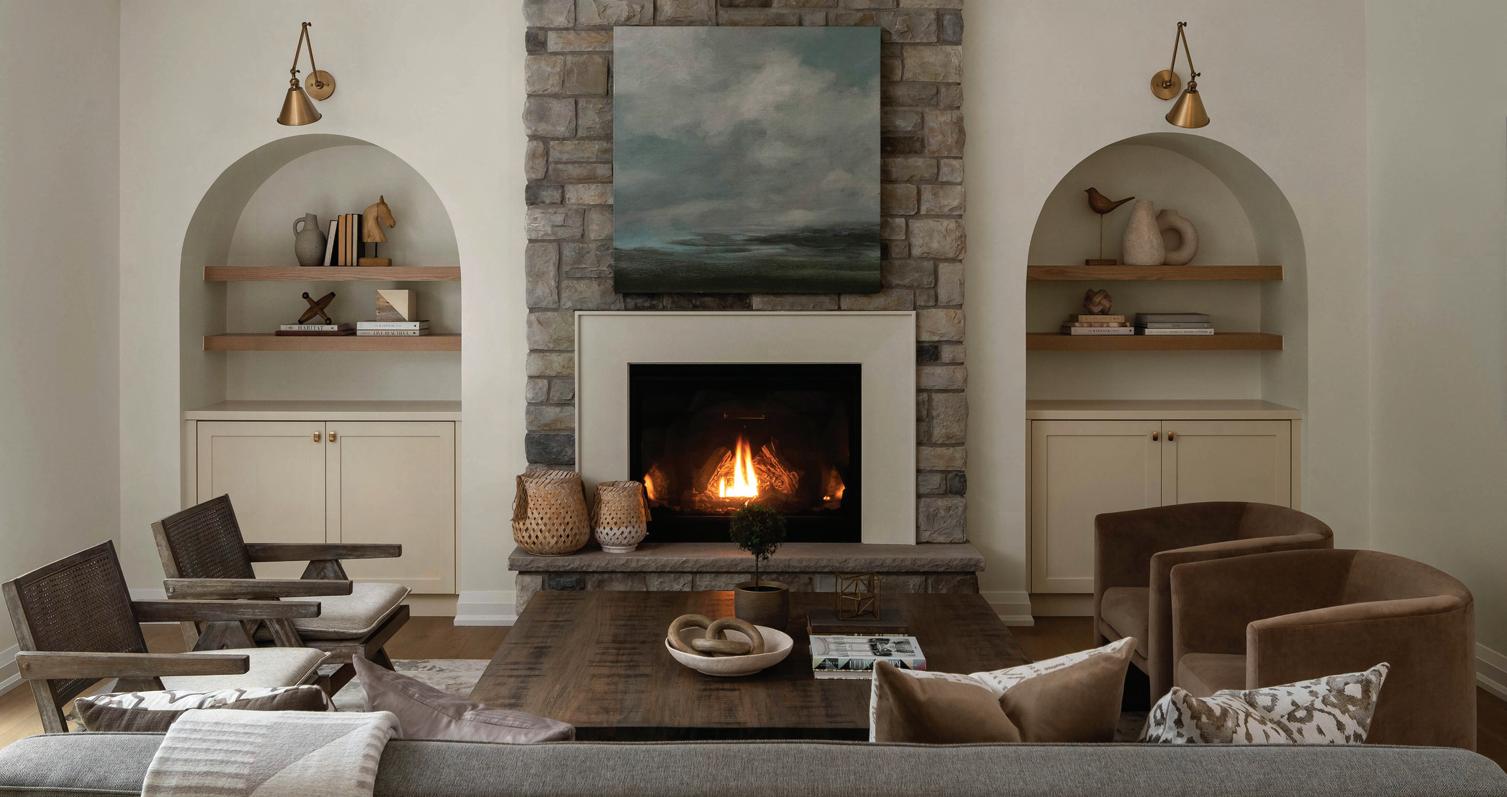

add warmth, comfort, and safety.
In addition to the home’s many unique design features that are visible, there are also hidden green elements that contribute to energy efficiency and comfort. “Besides the passive solar configuration, triple-pane windows, and natural ventilation, we also included solar panels, battery storage, radiant in-floor heating, and a natural gas generator for backup,” said MacDonald. “Our clients came to us with the goal of creating their dream chalet. This was a very special project for us, and a great experience. Working closely with the homeowners, the architect, and the interior designer, we discovered a lot of different things that we could do, within budget, to help them realize their dream.”
Among the chalet’s many interesting design features, Steve MacDonald credits designer Karen Kayne of Karen Kayne Interior Design Inc., for the chalet’s unique dining room. “This is one of my favourite rooms in the home,” said Kayne. “It’s a warm, eclectic, and inviting double-duty space, with a library at one end, a small workspace beside a picture window overlooking the pool, and a ten-foot window seat.”

“After having an interview with my clients and seeing their home in Toronto, I realized who they were and what was important to them,” Kayne adds. “As we spoke through the process, I felt that it was really important to add a lot of texture to the home, which creates warmth and makes it feel more homey, especially with its contemporary architecture. A perfect example is the large curtain wall. We juxtaposed that element with the millwork and the stone fireplace to keep everything balanced and bring the idea that the home is very liveable.”
According to Kayne, she and Andrew Slade collaborated closely throughout the project. “We were a team, and we really played off each other’s strengths,” she said. “Take the fireplace, for instance. The original concept was to have stone on all sides, but when I started to look at the space, I thought it would be really interesting to add another element to the design. Andrew and I considered several options, including copper, rusted weathered metal, and a hot-rolled steel look, but in the end came up with the idea of facing the entire middle portion with porcelain tile.”
Touring the home, this writer noted that virtually every room



“...AS WE MOVED INTO THE OTHER SPACES, WE LAID OUT OUR PALETTE AND MADE SURE THAT THE ROOMS JUST FLOWED FROM ONE TO THE NEXT.”
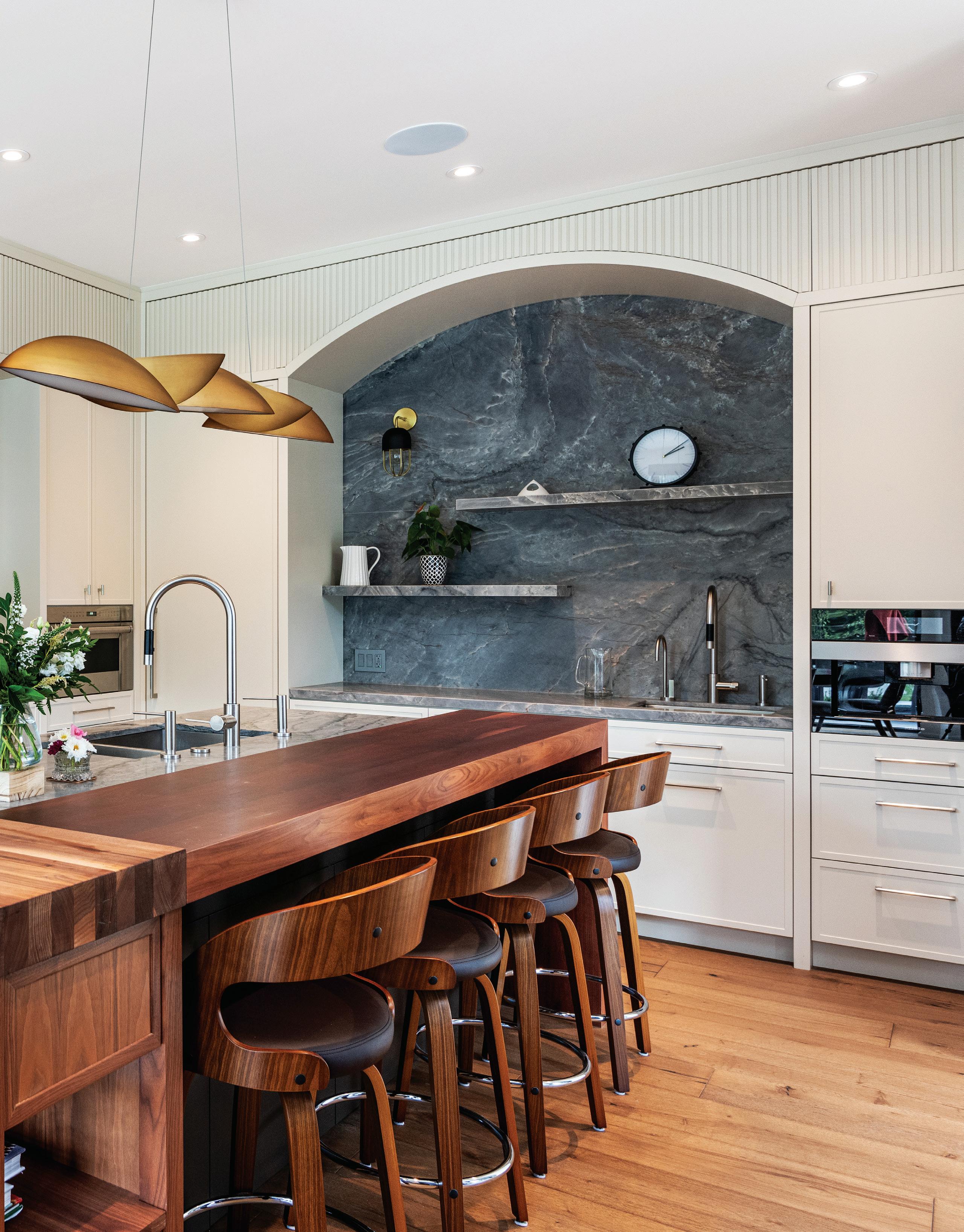

features warm oak flooring with light and colourful rugs. “The area rug in the living room was our jumping-off point. It does have a contemporary aesthetic to it, but the sculptural accents also add warmth,” said Kayne. “So, we built the entire room based on the rug. And then, as we moved into the other spaces, we laid out our palette and made sure that the rooms just flowed from one to the next. Similarly, the palette in the kitchen was also the jumping-off point to this space and the bar. We selected the stone first—a waterfall marble countertop in a solid wood island—and went from there.”
The lower level of the home, in keeping with traditional ski chalet design, is dedicated to fun and enjoyment, including a climate-controlled walk-in wine room, a golf simulator room, and a gym with an entire wall of vintage “stubby” beer bottles. A walkout from this level leads out to a stone-paved patio, swimming pool, hot tub, and a cabana/bar that complements the home’s design.
“The pool checked all the boxes for the homeowners,” said Tyler MacArthur, owner/operator of Georgian Bay Pools Inc. “It’s big enough for the grandkids to play around, with lots of depth to jump in, but not so big that it requires a lot of maintenance. We worked in concert with PattyMac Inc., Oasis Landscaping, and the homeowners to choose the best design and system for them. We always first ask the key question of how our clients see themselves using their pool, then go from there.”





PattyMac Project Manager Alyssa Kirk was responsible for ensuring that the entire project was executed as smoothly and efficiently as possible, prioritizing her clients and their needs every step of the way. She sums up her experience: “Everything in the home was designed with intention. There were many challenges because this home contains a lot of bells and whistles and moving parts,” she said. One of her favourite features of the home is a backlit onyx countertop in the powder room designed by Karen Kayne. “The architecture of Andrew Slade was amazing and everything in the interior is a testament to the talents of designer Karen Kayne. Sitting now in this finished home and looking around, everything I saw on paper has now come to life. It’s pretty wonderful to see.” E
SOURCE GUIDE
Architect: A. Slade Architects Inc.
Builder: PattyMac Inc.
Interior Design: Karen Kayne Interior Design Inc.
Windows: Tiltco Architectural, Bradford (curved curtain wall glazing); Muskoka Window and Door Centre, Bracebridge (all other windows)
Entertainment & Alarm Systems: Huronia Alarm & Fire Security Inc., Collingwood
Wood Flooring: Northern Wide Plank, Schomberg; eFloor
Specialty Flooring, Toronto
Landscaping: Oasis North Landscapes, Thornbury; design by A. Slade Architects Inc.
Electrical: Journey Electric, Collingwood
Plumbing: Current Plumbing Ltd., Collingwood
Masonry: Owen Sound Ledgerock, installed by Lloyd Masonry, Collingwood
Tile Installation: MCM D’Lusso Construction, Collingwood
Fireplaces: Chantico Fireplace Gallery, The Blue Mountains
Pool: Georgian Bay Pools, Collingwood








The Isla fandelier combines boho-modern style with practical performance. Natural cotton rope and a sleek drum frame pair with powerful six-speed functionality.
Georgian Design Centre
84 High St | Collingwood 705.444.2100 georgiandesigncentre.ca

Bring local character to your space with this antiqued chart of Georgian Bay. Decorative yet functional, it sparks conversation as guests discover familiar landmarks.
Barebirch
920 2nd Ave E | Owen Sound 226.664.2273
barebirch.ca
Ensure your water’s safety with an Ultra Violet Sterilization system for your home or cottage. It’s a sensible choice for treating your water effectively.
Water Depot
689 10th St W | Owen Sound 519.371.1111 waterdepot.com
2 3 4
This antique-inspired cabinet showcases overlapping double doors and rounded accents.
Crafted from solid pine with a distressed finish for rustic charm.
Van Allan Design Centre
150 First St | Collingwood 705.293.4663
vanallandesign.com







Come Walk With Me, by Debra Lynn Carroll. 40" x 60", oil on canvas. Loft Gallery 18 Bruce St | Thornbury 647.296.9797
Fall is here—stop in for seasonal and Thanksgiving décor, plus thoughtful hosting gifts.
Stay awhile and enjoy our new cozy fall lunch and dinner menu items.
Katherine’s Château Bistro & Home Decor Boutique 243 Ste Marie St | Collingwood
249.882.0159 katherineschateau.com
7
Create your own custom candle. Made of scentless, fine granulated wax, Candle Sand can be poured into any vessel of your choice. Simply insert the included wicks and light to enjoy a warm, long-lasting glow. Dawe and Company 115 Hurontario St Unit 101 & 104 | Collingwood daweandcompany.com
8
Make a bold statement with the Canadian-made MAAX Brioso freestanding tub, where timeless design meets everyday luxury.
LakeHouse Bath+Kitchen 603 Berford St | Wiarton 519.477.1900 lakehousebath.ca
Craigleith in Autumn, by Canadian Artist William Biddle, part of the Georgian Frame Collection. Double matted in a wood-grain frame with reflection-reducing glass, or customize the framing to suit your décor.
Georgian Frame Gallery
20 Balsam St Unit 12 | Collingwood 705.445.4477
Experience La Cornue with the industry’s longest warranty, a palette of refined colours, and your choice of brass or nickel accents— available in induction or dual fuel.
Tom the Dreamer
Mattresses & Appliances
21 Arthur St W | Thornbury 519.379.8440
dreamingtom.com
Clear your yard this fall with the Echo PB-770T. Delivering 756 CFM at 234 MPH and all-day comfort, it makes cleanup a breeze.
Robert’s Equipment
Chesley, Meaford, Owen Sound & Walton
robertsequipment.com
Elevate your home with a custom-made vanity designed to fit your style and space. Let our team help you craft a personalized blend of function and beauty.
Exquisite Wood Designs
1980 20th St E | Owen Sound 519.370.0808
ewdesigns.ca




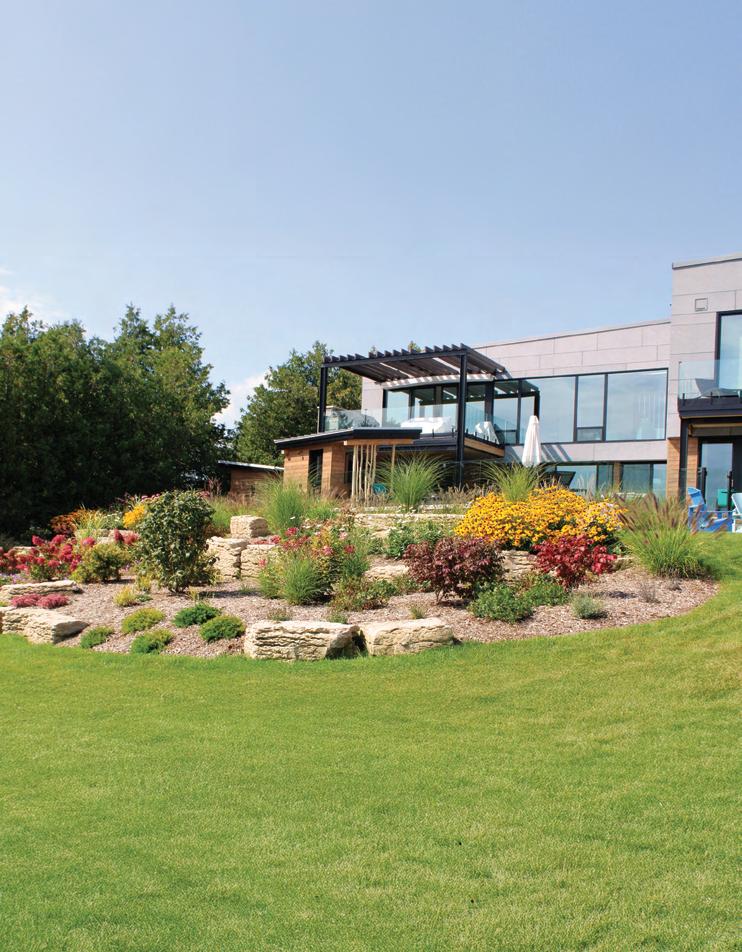














At Cobble Beach, a split-level retreat designed by architect Andrew Slade captures the sunrise, the Sound, and the essence of modern coastal living.
By Marc Huminilowycz | Photography by Clay Dolan

Driving north from the City of Owen Sound beside the water along 2nd Avenue West, the road changes its name to Grey Road 1 in Georgian Bluffs and suddenly, the feel of a shipping port town transforms into a casual coastal vibe as the sapphire-blue waters of the inlet, also called Owen Sound, open wider and wider into Georgian Bay.
It is here that the spectacular waterfront golf resort community of Cobble Beach was opened in 2007, offering an acclaimed golf course and a collection of homes reminiscent of Cape Cod or New England. And it is here amid the development—but not part of it—that the veterinarian owner of a busy Sauble Beach clinic and his wife, the veterinary technician who helped build the practice, created their dream waterfront home.
“Judy and I raised our family in Sauble Beach, and when our kids moved out, we moved across the peninsula to Big Bay,” said veterinarian Kevin Belbeck. The couple’s next move for their retirement resulted from an opportunity to buy a stretch of private waterfront land on the Sound, with a pebbled beach dotted with driftwood.
“This double lot was the family cottage of the wife of a veterinarian friend we met in the early 1990s. We often came to visit the couple throughout the ’90s, well before Cobble Beach was built,” said Dr. Belbeck. “Around 2015, we let them know that if they ever wanted to sell the property, we would be interested.
Initially, they were going to renovate and make it their summer home, but a few months later they contacted us to say their plans had changed and that they were ready to sell.”
Kevin Belbeck and his wife Judy purchased the double lot with another couple in 2017 and, in 2020, hired architect Andrew Slade, a family friend, to help them design and build their home. “Andrew gave us an extensive questionnaire to create a thorough list of what we were looking for in our new home—basically a modern and contemporary space with main-floor living and a generous use of glass, stone, and wood,” Dr. Belbeck explained.
“I was pleasantly surprised that Kevin and Judy wanted to do something really modern, because it opens up a huge amount of opportunity to play with materials. But what impressed me was the sheer beauty of the location,” said Andrew Slade. “It’s a spectacular east-facing property with gorgeous sunrises over the water, a private cove, a cobblestone beach, and a view of the iconic Cobble Beach lighthouse. The Sound has so much going on, like stand-up paddle boarding, fishing, and watercraft of all kinds. The connection to the water is private, but it’s also very interesting and animated.”
Slade and the Belbecks pondered the best approach to the home’s design and positioning on the property. With sketches in hand, they asked themselves whether the site called for a two-storey home. “It really felt that this was calling for a split-level, which made so much sense on the water because it brought you to the shoreline without perching you too high above it, meaning that





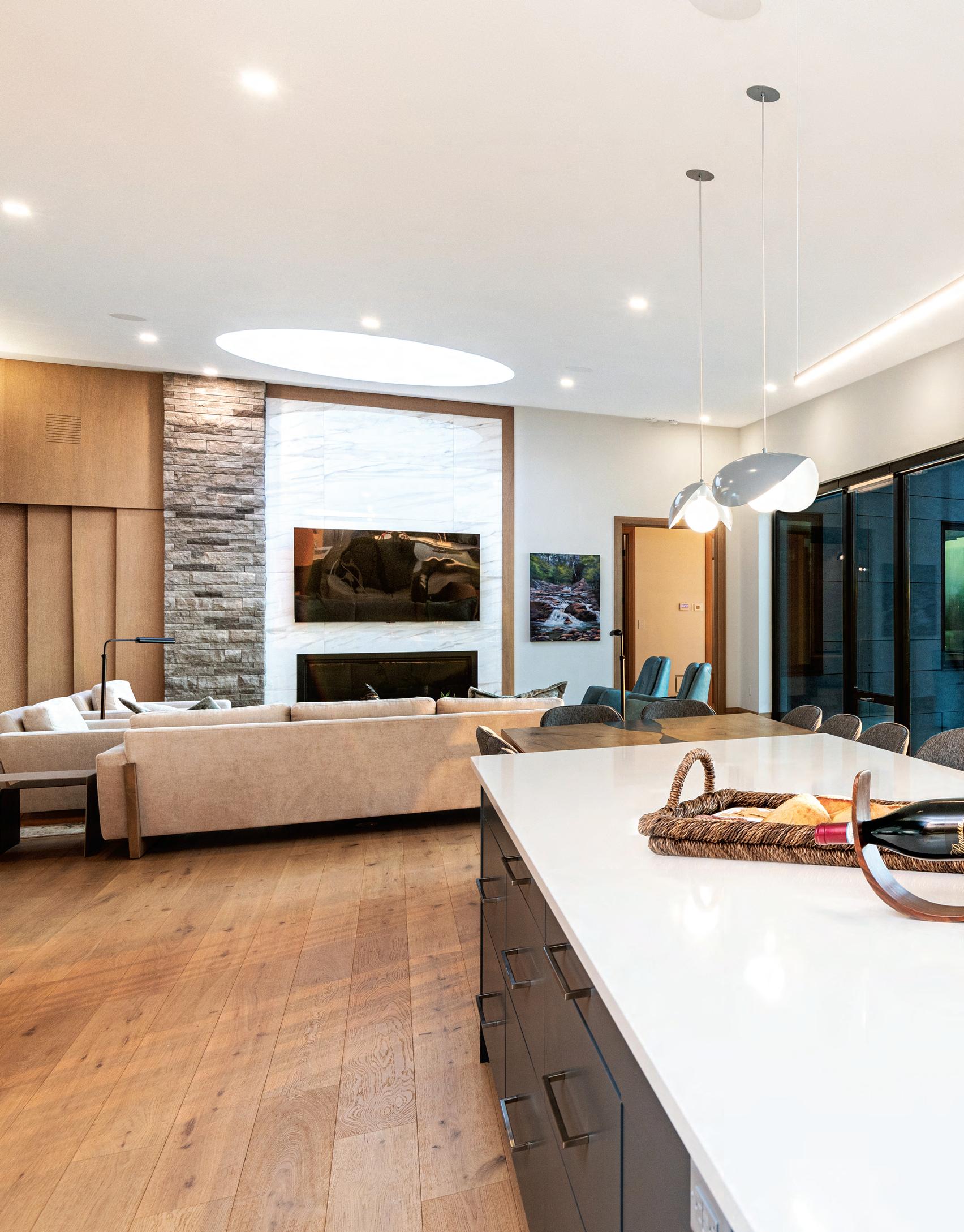



“IT’S

both the main and lower levels of the home could really be used simultaneously,” said Slade. “So, it’s really one level, including a primary bedroom suite and a walkout to the water from the lower level that includes two bedrooms with ensuites.”
The entire exterior of the home was designed to capture the coastal beachy feel of its surroundings, Slade notes. “The fibreelement panels we used are like an abstract version of raising the cobblestone out of the ground. And the light and warm beachwood Bellara lap siding lets the solid ‘cobble’ mass above it float.”
The front of the home faces west, which can be a challenge for controlling the intense sun at the end of the day. “The common solution to this issue is blinds, but we decided to look at this as an opportunity to add a unique feature to the home instead,” said Slade. “Knowing that a window was needed on this side of the house for curb appeal, cross-ventilation, and light balance, we decided to use vertical louvers as a natural sun-shading device.”
wood aluminum Knotwood louvers from Praxy Cladding were carefully measured and tilted to the sun to provide shade when direct evening sunlight could enter the home and cause unwanted glare in the main living area. They also provided privacy from the street while offering the homeowners an unobstructed view outside. “Much like the live timber features used elsewhere on the home, reminiscent of driftwood, these vertical louvers create an abstract relationship with the beachy, almost Tiki hut kind of vibe of the surroundings,” added Slade. “The same colour tone was used in the front doors and garage doors to spread warmth across the cobble-like exterior panels and Ebel Quarry stone.”
On the water side of the home is a unique pool, designed in an aesthetically pleasing curvy shape and, to maximize the space, tucked in right beside the home, ready for a morning dip. Designed and built by Clark Pools and Spas in Owen Sound, it features stainless steel walls and a concrete base finished with an Island



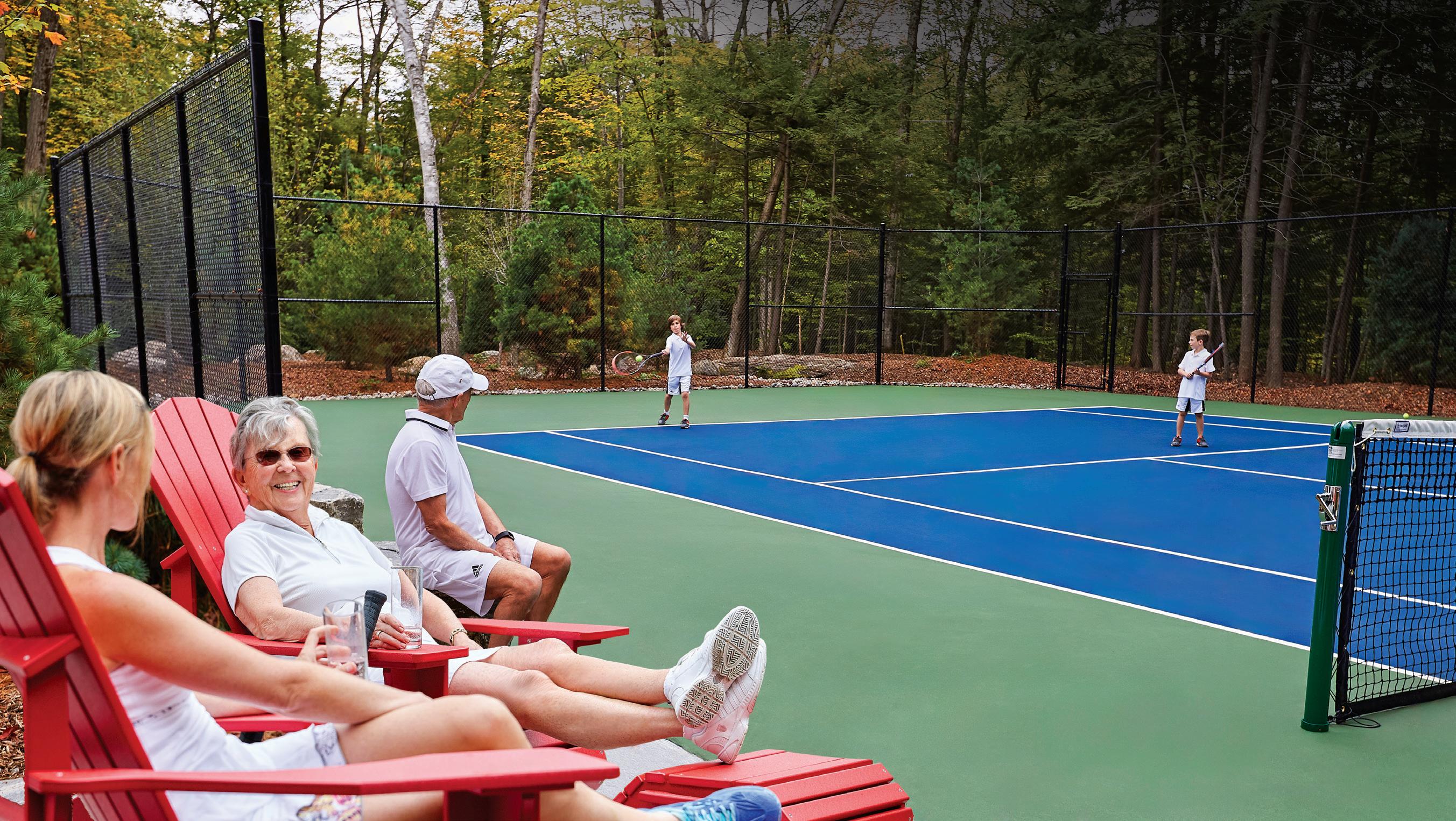

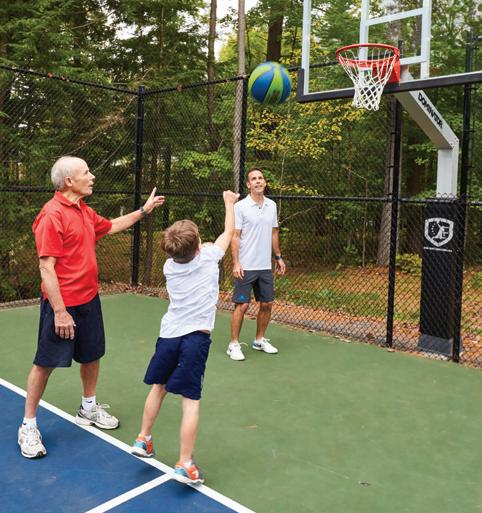

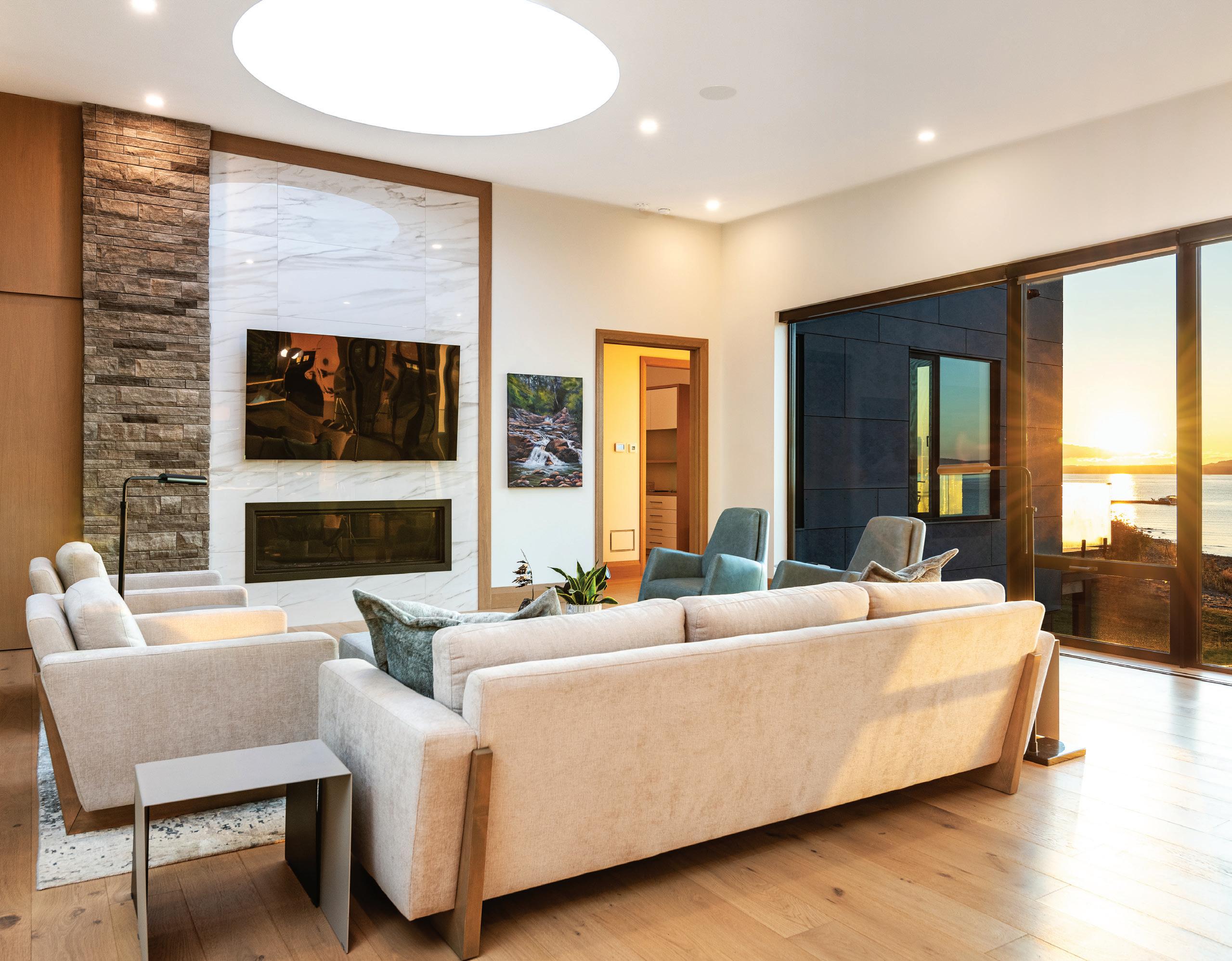
Wave border and Terrazzo pool liner that evoke a Caribbean feel. An outdoor kitchen and a cabana in the backyard/courtyard area add to the home’s relaxed coastal vibe.
“The pool’s coping is made up of twenty flat stone pieces, measured and laid out by Bloodworth Masonry, cut to measure by Ebel Quarries, and then installed by Bloodworth,” said Dr. Belbeck. A focal point of the pool is a large natural “jumping rock,” reclaimed and moved from another part of the property which, according to Belbeck, keeps the grandchildren entertained— climbing, standing, and jumping in the deep end.
Inside the home, the split-level design is cleverly planned, with the main-floor bedroom stacked directly above one of the lowerlevel bedrooms to optimize plumbing and drains. This wing of the
home is tilted five degrees to create more privacy and, with windows opening to the pool, a sense of having more space in which to enjoy outdoor living by the water.
“The split-level design makes the home feel more connected to the land and the water,” said Andrew Slade. “And the triple-pane windows from Tiltco Architectural are major elements of the design, as they not only let nature through the home by providing natural cross-ventilation, but also help insulate the home and block exterior sound, while connecting the homeowners to the shore.”
Adding to the airiness of the home, a skylight in the master bedroom is placed so that the homeowners can gaze up at the stars and watch the raindrops fall on a rainy day. Corner glass in the room connects the couple to the water. When they’re not stargazing






or enjoying the view, they can activate a Nexus hidden TV to rise up magically from a cabinet at the foot of their bed. This is one of many home automation features of the home—door locks, lighting, blinds, and switches—all Bluetooth-controlled via phone app, installed and designed by Balaklava Technology Simplified.
“Another round skylight in the main living room acts as a sundial and connects the homeowners with their beautiful, always-changing Georgian Bay skies,” said Slade. “These skylights, including one in the powder room, are commercial quality from Artistic Skylights in Woodbridge. They imbue natural daylight and add a pleasant glow from the ceiling.”
According to Slade, many materials used in the home were chosen to carry the inside outside and vice versa, in a seamless, continuous, and aesthetic way. These include white oak soffits/ ceilings to provide warmth and texture, driftwood elements to complement the beach vibe, and the use of quarry stone on fireplaces that speak to the use of local materials and character.
“The fireplaces, built and installed by a local company, Chantico Fireplace Gallery, complement the beach with soft stone and mimic the ideas throughout the home,” he said.
Andrew Slade gives full credit to local (Wiarton) builder Mallard Construction Inc. for bringing the Belbecks’ wish list and his vision of the home to life. “I could tell right away that these were the guys for the job,” he said. “They always asked questions







six steps ahead and never shied away from a different or difficult detail. Execution and collaboration with Dave and their team was excellent. There’s nothing more satisfying than showing up at the site and saying, ‘That’s exactly what I was hoping for.’ These guys did that over and over again.”
As the sun rises over the blue waters of the Sound, illuminating the cobblestones and driftwood on the shore, Kevin and Judy Belbeck give thanks to the creativity and craftsmanship of their architect, builder, and suppliers for making their retirement dream on the water come true. E
SOURCE GUIDE
Builder: Mallard Construction Inc., Wiarton
Architect: A. Slade Architects Inc., Collingwood
Interior Design: House Rules, Hanover - Heather Smillie & Tamarisk McNalty Stephens
Engineering: Dennis Nadon, Witzel-Dyce
Windows: Tiltco Architectural
Kitchen & Bathroom Cabinetry: NC Custom Cabinetry, Meaford
Window Coverings: Balaklava Technology Simplified, Walkerton; House Rules
Appliances: Square Deal Neil’s, Southampton
Entertainment & Alarm Systems: Balaklava Technology Simplified Bathroom Fixtures, Plumbing: Prentice Plumbing & Heating, Owen Sound
Exterior Lighting Design: A. Slade Architects Inc. and Outdoor Environments, Wiarton
Landscaping: Outdoor Environments, Wiarton
Electrical: G&M Electrical Mechanical Ltd., Sauble Beach
Drywall: PrimeTime Drywall, Owen Sound
Concrete Foundation: Cretewerx, Elmwood
Masonry: Bloodworth Masonry, Hepworth; Ebel Quarries, Wiarton
Interior Flooring, Bathrooms, Pool Area work: Ironmonger Interiors, Wiarton
Exterior Façade: Praxy Cladding Corp, Mississauga; Engineered Assemblies, Mississauga
Fireplaces: Chantico Fireplace Gallery, The Blue Mountains
Retractable Awning: Shade FX, Mississauga
Showers: Shore to Shore Glass & Mirror, Owen Sound
Roofing: DJ Peat Roofing, Annan; AM Roofing, Owen Sound
Skylights: Artistic Skylight, Woodbridge
Front Door: Fibrecraft Door Company, Hanover
Garage Door: Peninsula Overhead Doors Inc., Allenford

















Thinking about hitting the slopes for the first time? From beginner programs and insider tips, here’s your guide to getting started this season.
By Cara Williams | Photography courtesy of the Canadian Ski Council and RT07



Around here, skiing and snowboarding are stitched into winter with a promise of fresh air, fun and lots of laughs. But for anyone new to the sport, that promise often comes with one nagging thought: where do I even start? Add in the reputation for being pricey and intimidating, with unspoken rules, insider lingo, and gear that seems designed to confuse. No wonder plenty of people figure it’s easier to stay indoors with a blanket and the remote.
The truth is, skiing and snowboarding aren’t as out-of-reach as they might seem—especially now. Over the past decade, a few dedicated entities have been quietly working to make that first step onto snow easier, less expensive, and far more welcoming. At the centre of this push is the Canadian Ski Council (CSC), the trade association that represents ski areas across the country. Their public-facing brand, Go Skiing/Go Snowboarding, exists for one simple reason: to get more people outside in winter, whether that’s on skis, a snowboard, or Nordic gear.
“Getting into our sport is not easy. It’s a little bit daunting,”
admits Paul Pinchbeck, President and CEO of the Canadian Ski Council. “We’ve learned over the last couple of decades that the right information and a welcoming first experience can make all the difference.”
That philosophy drives Never Ever Days, one of the Council’s most impactful programs. Designed for absolute beginners, it bundles a lift ticket, rentals, and a lesson for a price that’s lower than most people expect. For a first-timer, it’s a worry-free way to see if sliding on snow is your thing. More than 70% of participants are new Canadians, and women are turning up in even greater numbers than men. “The industry is generally about 62% male, but with Never Ever Days we’re seeing 62–63% women participation,” Paul says. “It’s pretty cool.”
These programs are about more than just selling a package—they’re about taking away the stress before anyone even clicks into a ski. Resorts that participate have marketing, registration, and guest communication handled by the CSC, with step-by-step details for newcomers on where to park, how to find the rental shop, what to bring, and what to expect.
In our area, Blue Mountain, Snow Valley, Mount St. Louis


Moonstone, and Horseshoe Valley have all been involved, with more expected to join.
For young skiers, the SnowStart Kidz Pass—an expanded version of the well-known Grade 4/5 SnowPass—now includes grades 1 through 6, offering three visits at each participating ski area. “In some cases, up to 30% of the family members are learning to ski,” says Paul. “The more they ski, the more likely they are to stay as a family that skis.” It’s the kind of virtuous cycle the sport thrives on: one child falls in love with skiing, the parents join in, and suddenly winter becomes something the whole family looks forward to.
Paul is quick to point out that this is about much more than just growing numbers. “We believe skiing and snowboarding provide significant mental and physical health benefits on a yearround basis. We’re the antidote to the winter ‘sit on the couch’ type thing.” The pandemic made that clearer than ever, with people seeking safe ways to be active and connect. Skiing’s social side—the friendships that start on a chairlift and last all year— sets it apart from many other sports.
That community extends to Nordic skiing too. Often less
structured than alpine, Nordic saw its own boom during the pandemic. Paul calls it a “gateway sport” that often leads to alpine or snowboarding, though it’s also a satisfying pursuit in its own right. He’s returned to it himself, enjoying night skiing when his schedule allows.
Of course, there’s no ignoring the question of cost. The headlines may focus on the priciest lift tickets in the country, but that’s far from the whole story. “There are ways to participate… that are much less expensive than what one reads in the popular press,” says Paul. Smaller ski areas close to urban centres, midweek passes like Blue Mountain’s 5x7® Pass, and the Canadian Lift Pass program—a shareable pack of five discounted tickets—are all part of the picture.
One of the best places to see the energy of skiing and snowboarding come to life is the Toronto Ski & Snowboard Show®, produced each fall by the Canadian Ski Council. After decades near the airport, the show moved downtown to Exhibition Place, making it easier to reach by transit and giving it a lively urban edge. “It’s the official kickoff to winter,” says Paul. “It’s evolving beyond a place to pick up an inexpensive piece of
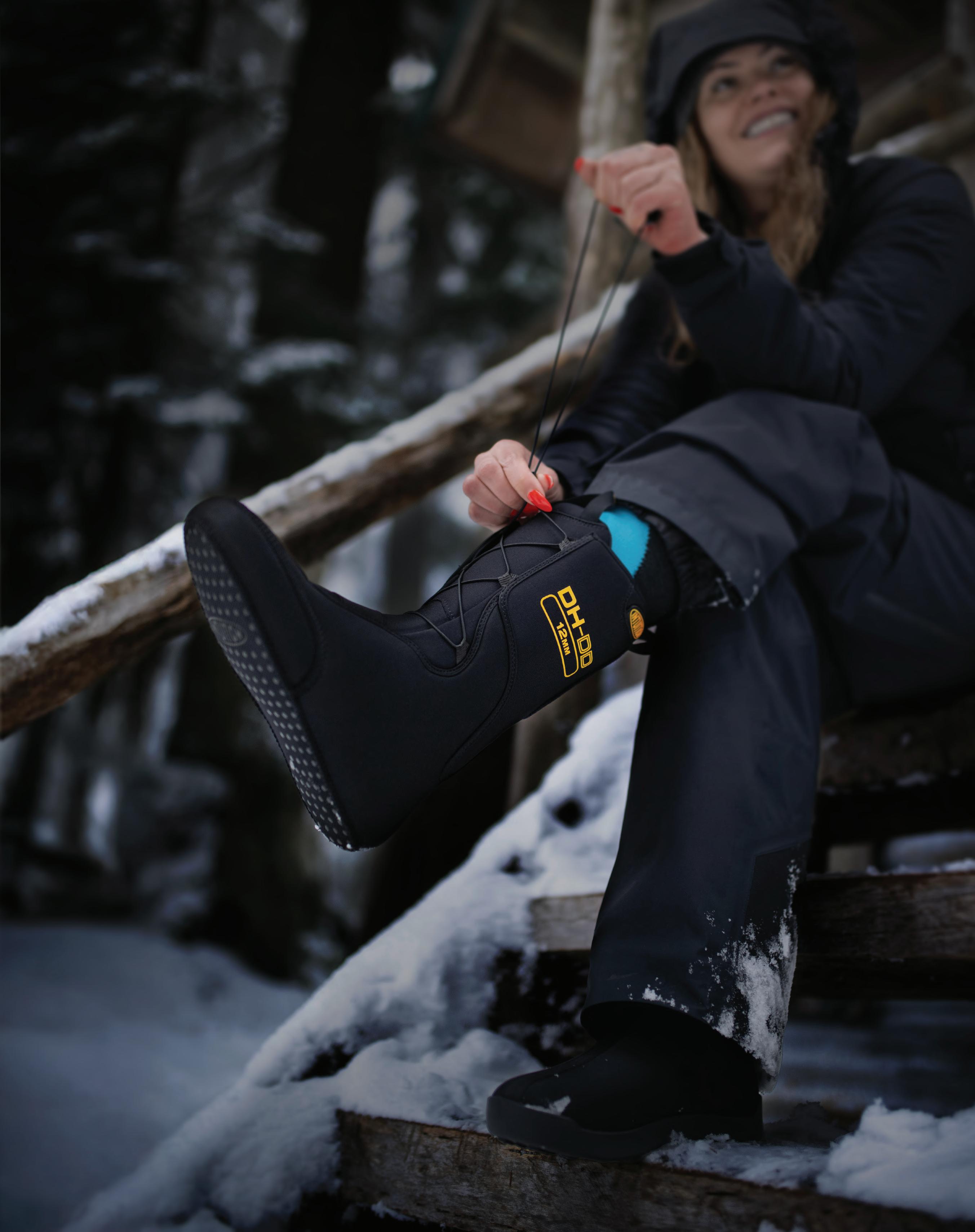
gear—it’s a cultural gathering, a place to catch up and launch the season.” Each year the show draws tens of thousands of winter lovers with Canada’s largest ski and snowboard swap, dozens of retail exhibitors, travel opportunities, and the latest-and-greatest products. This year’s theme, “chalet chic to steep and deep,” blends home décor inspiration with a fully licensed après ski area, complete with live music. Part gear swap, part reunion, part party—the Toronto Ski & Snowboard Show is as much about community as it is about equipment.
And if cost is still what’s holding you back, there’s a brandnew local initiative designed to tackle that barrier head-on: Second Tracks. A partnership between the YMCA of Simcoe/ Muskoka, North Shore Ltd., and Blue Mountain Resort, Second Tracks is aimed at youth who might not otherwise have a chance

to ski or snowboard. Open to ages 12 to 16, it offers two fourweek sessions where kids receive complimentary nightly lift tickets, rentals, lessons, dinner, and round-trip transportation from the Collingwood YMCA. The goal is simple: break down barriers and give teens a safe, welcoming, and fun place to learn. “I’ve often wondered what it would be like to grow up in Collingwood with a ski hill lit up at night, but never have the chance to try it,” says John Mealey, founder of Second Tracks. “This program gives kids the opportunity to see their town from the top of Blue Mountain and, in real time, shift their perspective on what’s possible. It also helps bridge the gap between the local community and the private ski clubs by opening the door for local youth to experience the thrill of skiing and snowboarding.”
With volunteers and professional instructors guiding each


PERFECT STORM SKI VACATION PACKAGE. ENJOY MORE DAYS TO PLAY—FOR LESS.
SAVE UP TO 15% ON LODGING AND GET A FREE DAY OF ADULT LIFT TICKETS FOR STAYS JANUARY 1 – MARCH 27, 2026 WHEN YOU BOOK A MINIMUM OF FOUR NIGHTS OF LODGING WITH FOUR DAYS OF SKIING.



session, the program blends athletic skill-building with social time, fresh air, and plenty of encouragement. Community members can help too, by volunteering on the hill or donating gently used equipment and funds. For full details, visit secondtracks.ca.
Taken together—from national initiatives to cultural gatherings to grassroots efforts like Second Tracks—affordable lift options, beginner-friendly packages, used gear, and community events are making snow sports feel far less intimidating. They’re
starting to feel, well, inviting. “Whether you’re at the Peaks looking out over the Bay, at Blue Mountain, or on a small hill close to home, every ski area has its own charm and culture,” Paul says. “It’s about being active, being social, and embracing winter in all its beauty.”
If you’ve ever thought skiing or snowboarding might not be for you, maybe this is the year to prove yourself wrong. Take that first run—you might just find your new favourite winter activity has been waiting for you all along! E

Ski and snowboard at some of Canada’s greatest destinations for less.

Kitzbühel Champions
Supporting Escarpment Excellence on the World Cup!
This year’s goals are to directly support five Canadian World Cup athletes with roots in the Escarpment as well as to assist Alpine Ontario to achieve key funding priorities.






Please join us for an incredible evening featuring the first ever gathering of Canada’s Hahnenkamm Champions, including Jack Crawford by video link to discuss his historic win and Canada’s legacy at Kitzbühel and on the White Circus.
This year’s exclusive Canadian Kitzbühel Champion panel will be moderated by Rod Black – a 40 year sportscaster with CTV Sports and TSN
Steve Podborski (CAST 1974-1984, 8x World Cup Winner, 1982 World Cup Downhill Crystal Globe,1981 and 1982 Kitzbühel Champion, Olympic Bronze Medalist)
Ken Read (CAST 1974-1983, 5x World Cup Winner, 1980 Kitzbühel Champion)
Todd Brooker (CAST 1977-1987, 3x World Cup Winner, 1983 Kitzbühel Champion)
100% of the proceeds form the event will go directly to our 5 athletes as they prepare for Milano Cortina as well as support Alpine Ontario in achieving key funding priorities to help Ontario athletes find their Path to the World Cup.
Dinner is limited to 200 Participants who want to make a difference by supporting these athletes directly (Dinner Gala tickets are $500 per person, $5,000 per table of 10). All tickets and donations are eligible for a tax receipt from Alpine Canada.
LOCATION: Georgian Peaks Ski Club
DATE: November 22nd at 6pm
RSVP & QUESTIONS: 705-444-4777 or nick.hamilton@rbc.com





By Cara Williams | Photography courtesy of Alpine Canada

Clarksburg’s Kyle Blandford first clicked into skis at age six. From those early days at Toronto Ski Club (TSC), he moved steadily through Ontario’s development pipeline—rising from Snow Stars to the Ontario Ski Team. Along the way, he built a name for himself on the national and international stage, with podium finishes in U21 NorAm events, a third-place at the Canadian Giant Slalom National Championships, and a fourth-place team result at the World Junior Championships.
When faced with the choice between a U.S. university offer and continuing his development in Canada, Kyle stayed the course—joining the Canadian Alpine Ski Team in 2024. Now 22 and in his second season, he’s racing Downhill, Super G, and Giant Slalom, named to Alpine Canada’s Olympic long list, and aiming for his first World Cup start. Training alongside top-tier athletes—including fellow Escarpment skier and Hahnenkamm champion Jack Crawford—he’s learning from the best while carving his own path.
We caught up with Kyle between training camps to talk about his roots, rookie moments, and what it takes to turn small-hill dreams into big-mountain results.
Cara Williams: First off—congratulations! How did it feel when you found out you made the Canadian Alpine Ski Team?
Kyle Blandford: The feeling was unreal. My family and I were very excited that I got to have this opportunity. It was a dream come true. It’s the kind of moment you work toward for years, and now I’m looking forward to making the most of it. I’ve had the goal of being on the Canadian Ski Team since I was 12 years old.
CW: What drew you to ski racing, and what do you remember most about those early years at Toronto Ski Club?
KB: What drew me most was the feeling of going fast while being in control—it’s a kind of freedom that’s hard to describe. I remember having so much fun in group lessons, going into the terrain park, skiing the trees, and just enjoying that sense of freedom. I had some
great coaches who made training fun. I didn’t start racing as early as some others because I lived in London, and we only came up on weekends.
CW: Throughout junior ski racing, your pathway kept building: U16 at Georgian Peaks, then to the Southern Ontario Division (SOD) Team, then onto the Ontario Team. At any point, did you consider the U.S. academy route like Burke Mountain Academy or Green Mountain Valley School?
KB: I had some discussions with my family about going to a U.S. academy going into my first year of FIS. But I had a really strong and competitive group of teammates in the SOD program, which made me want to stay. We also had great conversations with people like Kip Harrington and staff from both SOD and the Ontario Ski Team. They helped me see the value of staying in Ontario and aiming for NCAA—or even the national team.
CW: Like most ski racers, you missed a lot of school— upwards of 80 days a year in high school. Was it tough to juggle academics and training?
KB: For sure, it was tough managing academics with ski training and racing, but I went to a really good sports school, Oakville Trafalgar High School. The school supported a flexible academic structure for Grades 11 and 12. I also had amazing teachers and staff who valued sports. One mentor in particular, Wendy Malloch, played a huge role in keeping me on track. Having that kind of support system made a massive difference in both my education and my ability to pursue the sport seriously.
CW: You also have a background in other sports—track, hockey, even varsity volleyball. How did being a multi-sport athlete help you develop as a skier?

Clay Dolan
KB: Being a multi-sport athlete has been a huge advantage for me as a skier. Playing varsity team sports like hockey and volleyball gave me a broader set of physical and mental skills that carry over to skiing. Some of my best memories growing up are from competing in different sports and feeding off that competitive drive.
CW: You were offered a spot on the Montana State University Alpine Ski Team. What made you decide to stay in Canada and stick with the national team?
KB: I feel really fortunate to have been offered a spot at Montana State. It was a huge goal of mine to go to an NCAA school. They have an excellent program and team. For me, it came down to what I wanted to achieve personally in the sport. As a speed skier, it made the most sense to stay in Canada and continue developing within the national team program, given that NCAA programs and racing only focus on slalom and giant slalom.
CW: Has anyone on the team taken you under their wing or offered some solid advice?
KB: Honestly, everyone on the team has been great in offering advice, guidance, and little tips here and there. If I had to single out one person, I’d say Jack Crawford has been especially good with the new athletes. Having someone like him, who’s been through it all, makes a huge difference. He sets a high standard but is also approachable and encouraging.
CW: Any rookie moments you’re willing to share?
KB: No crazy rookie moments yet, but I’m still in the process of learning the ropes. The biggest adjustment has been adapting to life on a true high-performance team. The commitment and professionalism are on another level. Every detail—from training to recovery—is dialled in, and it’s pushed me to raise my standards. It was overwhelming at first, but I’m finding my rhythm and growing a lot because of it.



CW: What does a typical training day look like for you right now?
KB: The first camp was in Saas-Fee, Switzerland, and the schedule was pretty intense. We’re up early—around 4:00 a.m.—to load at 5:15 a.m. so that we can get the best snow conditions. We start with a proper warm-up before getting into training runs. On a typical day we’ll do anywhere from 8 to 12 runs, depending on the focus, and then finish off with a cool down to make sure we’re recovering properly. After skiing, there’s dryland or weight training, recovery work, and video review. We also meet with our service team to go over equipment. The day usually ends with a team debrief. It’s a full schedule, but that’s what it takes to perform at the highest level.
CW: Are there any specific goals or benchmarks you’ve set for yourself?
KB: I’ve set a few ambitious but realistic goals. I’d like to find success on the Europa Cup circuit, go after a Nor-Am title, and earn a World Cup start. At the same time, I’ll try to keep things simple by focusing on the process—continuing to improve my skiing, building consistency, and finding a little more speed with each race. I know if I stick to that approach, the results will come.
CW: Alpine Canada recently named you to its Olympic long list. What was it like seeing your name there—and what does that mean for your season ahead?
KB: Just seeing my name on that list was a surreal moment and something that really motivates me. The Olympics have always
been a lifetime goal—it’s what you dream about as a kid when you first put on skis, and to be on that path now is exciting. It’s also a reminder of how much work still lies ahead, but that part I enjoy.
CW: What’s one piece of advice you’d give to young skiers growing up on the Escarpment dreaming of racing for Canada?
KB: The biggest piece of advice I’d give is to make sure you’re having fun. It’s important to try different sports, spend time with friends, and enjoy the process. That’s what builds not just athletic ability but also passion for the sport. Skiing at a high level requires commitment, but if you don’t have that balance early on, it’s easy to burn out. I’d also say to believe in what’s possible. If you’re passionate and committed, you can absolutely make it to the highest level. E
Kyle is halfway to his $60,000 fundraising goal for the season. He’s once again being supported by Path to the Podium—an annual event dedicated to raising funds for Escarpment-based World Cup racers. This year’s event takes place Saturday, November 22 at Georgian Peaks Ski Club. 100% of funds raised will go toward supporting team expenses for national-level athletes with roots on the Escarpment and addressing program gaps for NextGen athletes through qualified coaching and development.
To support Kyle directly, email Kyle.Blandford2025@gmail.com to receive his sponsorship package.


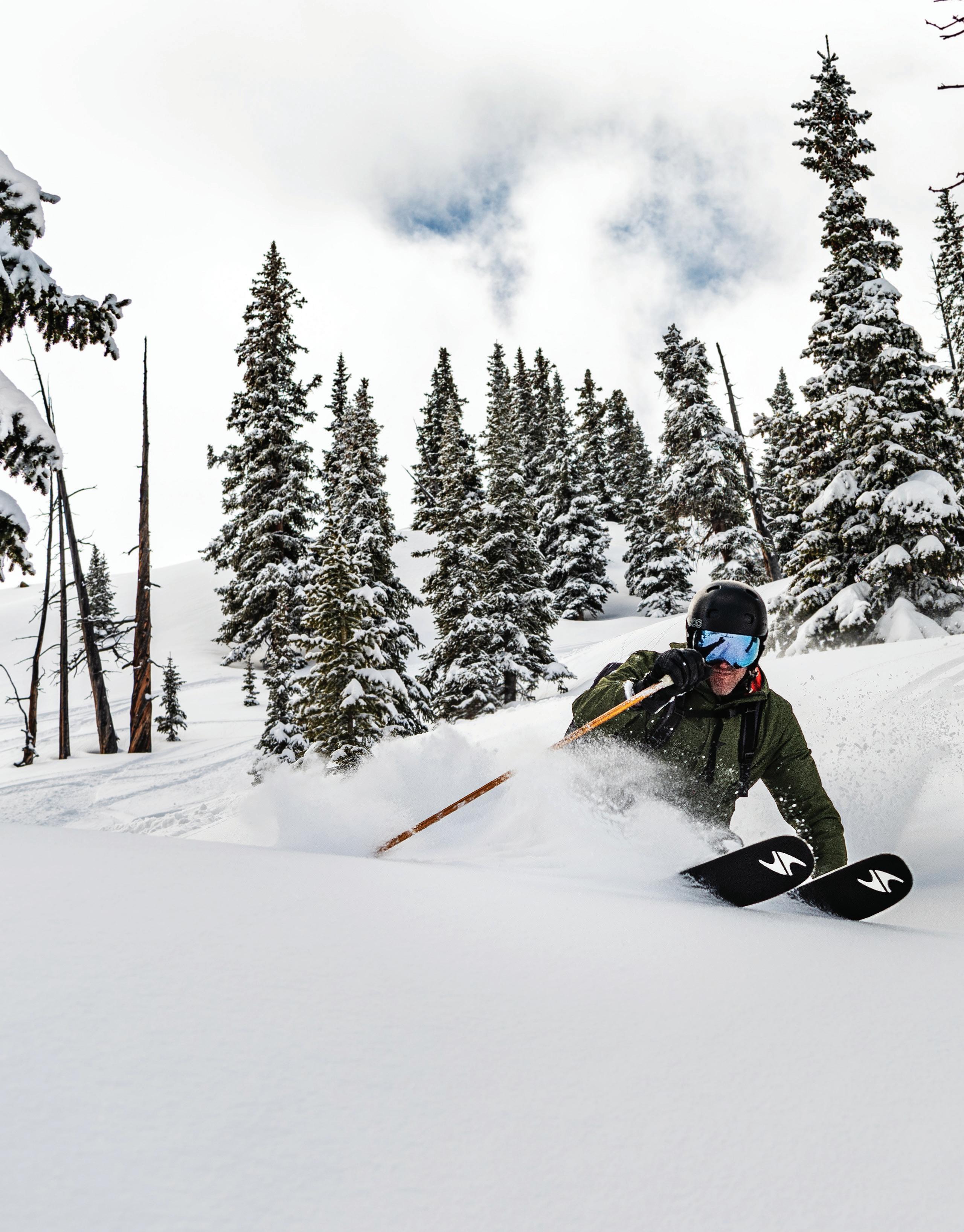

One Ikon Pass, four mountains, and an après scene that redefines indulgence—Aspen is where adventure starts at first tracks and lingers long past the last toast.
By Cara Williams | Photography by Clay Dolan

Colorado has always felt close to home for me. My husband grew up on the Western Slope, and the Rocky Mountains often hover at the edge of our conversations—usually powderday stories told with a reverence that makes towns like Aspen sound more like legend than landscape. Of course, I knew of it long before I ever experienced it in person, its glitzy slopes serving as the backdrop in films like Aspen Extreme and even Dumb and Dumber—who can forget the quote, “A place where the beer flows like wine... I’m talking about a little place called Aspen.” I first travelled there in my twenties, working events like the X Games, sharing crowded rentals, riding the chair in the pre-dawn hours, and working long after darkness fell. Back then it was all grit and hustle: work hard, sleep when you could, ski as much as possible, and save just enough for après—then wake up and do it all over again.
Over the years, the town settled into memory—part lore, part ache, and part reminder of what it means to truly chase snow. So, when Aspen Snowmass invited me back, it felt like the right moment to return, not as the exhausted pseudo ski bum I once was, but with a whole new assignment. Aspen Snowmass has supported Escarpment Magazine for years, and this visit felt less like an introduction than a continuation—a chance to see the mountains with fresh eyes. If those early trips were about hustle,
this one was about luxury. And this time the same Ikon Pass we use at Blue Mountain opened the door to all four of Aspen’s mountains—familiar plastic in my pocket, but a radically different playground beneath my skis.
Instead of hunting for a couch to crash on, we checked into The Little Nell. This Five-Star, Five-Diamond hotel is the only true ski-in, ski-out hotel at the base of Ajax, the mountain that rises straight out of Aspen village. Named one of Travel + Leisure’s Top 10 Resort Hotels in its 2025 World’s Best Awards, The Nell is Aspen’s undisputed grande dame. From the moment we arrived, the concierge anticipated every detail before we even thought to ask. Boots? Warmed. Skis? Waiting at the gondola. Dinner? Booked at the perfect table. They’ll even switch out your gear mid-day if conditions change. In the morning, the Silver Queen Gondola is just steps away, and in the evening, après spills onto the Ajax Tavern patio—Champagne flutes clinking, the scent of truffle fries in the air.
We came in a rare window between the X Games and the FIS Freestyle World Cup, when the crowds receded and the town exhaled. Days dawned at –5°C, skies polished to bluebird perfection, and snow so perfect it squeaked underfoot. With Ajax, Snowmass, Highlands, and Buttermilk all accessible on the Ikon Pass (and a complimentary shuttle to each base), the hardest part was deciding where to start.




Aspen’s story as a ski town began in 1946, when a sleepy post-war village transformed into something truly amazing. The first runs were carved by veterans of the U.S. Army’s 10th Mountain Division alongside some of Europe’s finest mountaineers—men and women who brought both courage and vision to the Rockies. Ajax Mountain, aka Aspen Mountain, quickly earned a reputation for world-class ski racing, hosting national and international competitions through the 1950s and ’60s. That legacy still hums beneath your skis today.
Even today Ajax doesn’t ease you in—there are no green runs here, just a fast, steep playground for confident legs. The newest jewel is Hero’s, a 153-acre expansion of double-blacks, glades, and chutes that boosts Ajax’s skiable terrain by 20%. Locals still call it Pandora’s, and they ski it with the same swagger as someone holding a secret they don’t really want to share. On the lifts, conversations flitted between the day’s conditions and sightings of familiar faces—Aspen has long been a magnet for the famous, from Justin Bieber to Kevin Costner to the occasional fashion house staging a photo shoot at the base of the gondola. Yet for all its glamour, it remains, at its core, a ski town. A place where the snow (and sun) still dictates the rhythm of the day.
One morning, our group was treated to the mountain an hour before the public. Riding the gondola in the quiet of first light, we spilled onto untouched corduroy, free to carve arcs across groomers that felt minted just for us. It was the kind of start that makes the mountain feel like it belongs to you alone. By the time we slid into Bonnie’s for breakfast, the sun had crept onto the deck and the air was thick with enticing aromas of strudel and pancakes.
Perched mid-mountain, Bonnie’s is more than a restaurant— it’s part of Aspen’s cultural DNA. German ski racer Gretl Uhl and her husband Sepp built it in 1966, passing it to Bonnie Rayburn in 1980, who gave the spot her name and her nowlegendary white bean chili. Today, Brigitte Birrfelder keeps the tradition alive with the same rustic simplicity and Bavarian fare. Generations of skiers have thawed toes here, shared buckets of beers, and fuelled up before another lap. Sitting with coffee in hand (it was only 9:30am), it felt like a bridge between Aspen’s storied past and the day still unfolding (there would be beer).






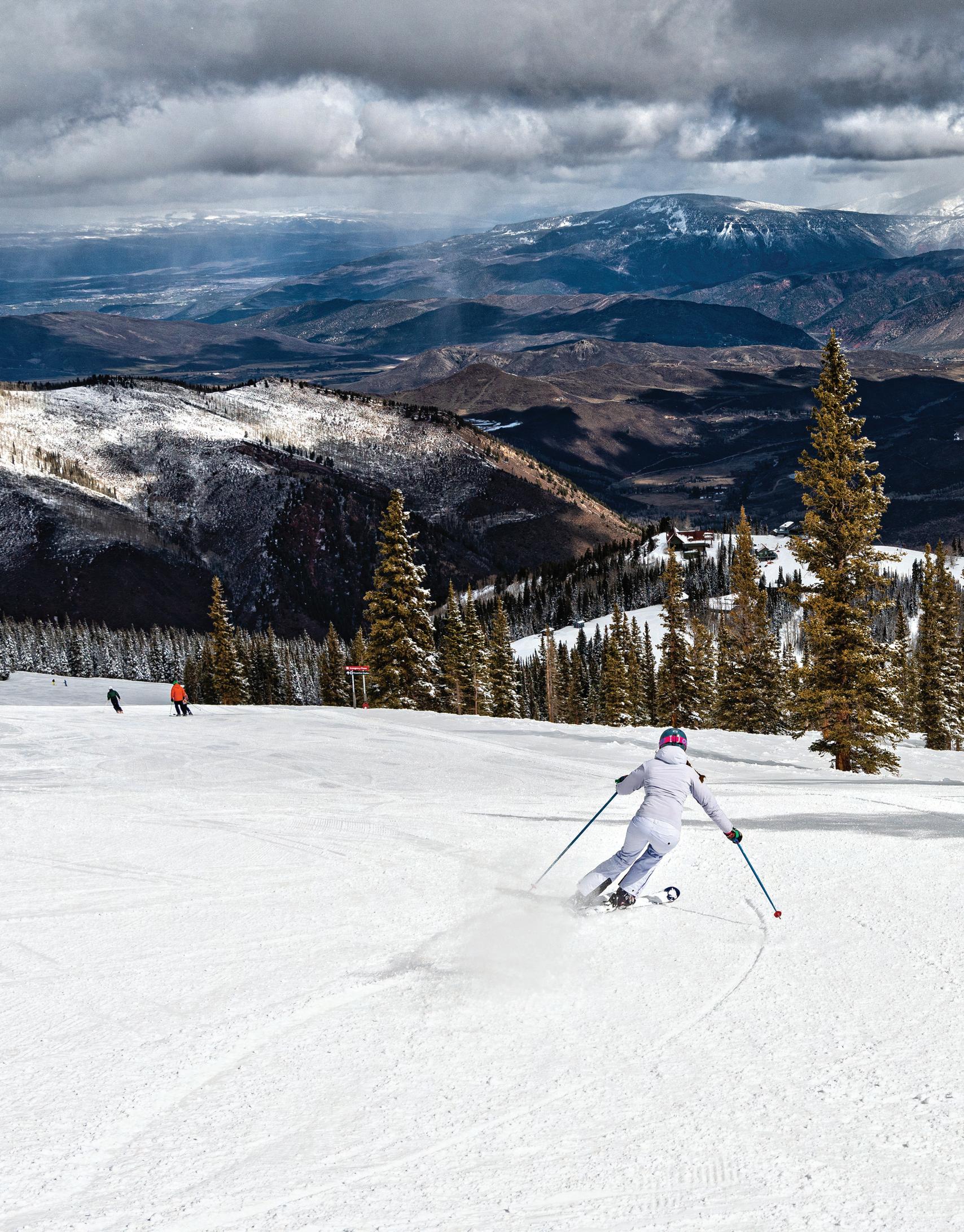

One minute it’s sunlit cruisers, the next it’s powder-filled bowls with no one else in sight. It’s the kind of mountain where you can ski bell-to-bell without repeating a run.


If you’re looking for adventure and adrenaline, Aspen Highlands is for the purists. This is the mountain where you come to test your mettle, and Highlands Bowl is the ultimate exam. It’s a 782-foot vertical climb from the top of the lift, and it’s all above treeline, with views that make you stop mid-step—not that you’d admit it. We had Butch, a local Enduro legend, as our guide. His scoring system is simple: +1 for every person you pass, –10 for everyone who passes you. I finished at –27, but the 1,400 vertical feet of chalky bliss waiting on the other side erased any ego bruising.
Snowmass, in contrast, is vast and sprawling—3,300 acres of variety. One minute it’s sunlit cruisers, the next it’s powder-filled bowls with no one else in sight. It’s the kind of mountain where you can ski bell-to-bell without repeating a run. Midday, skiers drift toward The Cabin’s Veuve Sun Club for an alpine toast, where flutes of Clicquot and sweeping views conspire to make the rest of the day feel optional.
And then there’s Buttermilk, Aspen’s most underestimated gem. Known worldwide as the stage for the X Games, it’s a freestyle playground with immaculate halfpipes and jumps. But it also hides some of the softest groomers and most sun-drenched laps in the valley—a reminder that skiing doesn’t have to be high stakes to be high joy.
In Aspen, skiing is only half the story. Après here is a cultural institution, and Cloud Nine Alpine Bistro on Highlands is infamous—a mid-mountain restaurant that transforms daily into a Champagne-soaked dance party that feels more Ibiza than Colorado. Picture ski boots on tables, bottles erupting like snowguns, the air thrumming with music and laughter. In the village, Ajax Tavern offers a more classic take: sharable plates,
Aperol spritz poured without hesitation, and people-watching so captivating it could count as its own sport. Meanwhile, back at The Little Nell, après slows to a hum—perhaps a soak in the heated pool, an infrared therapy bed that melts the day from your legs, followed by an early dinner at Element 47, the Michelin Guide–recommended dining room where the sommelier might suggest a vintage you’ve never heard of but instantly fall for. It’s après refined—less spectacle, more soul.
We also spent a few nights at the Limelight Aspen, just down the street. Less opulent than The Nell, but still polished and perfectly placed, the Limelight offered a laid-back counterpoint to the grandeur. The rooms were airy, the lobby buzzed with skiers swapping stories over wood-fired pizza and local craft beer, and the whole vibe leaned more communal than couture. Best of all, everything in Aspen was within easy walking distance—the lifts, the restaurants, even the designer boutiques I pretended not to peek into. For a skier who wants comfort, convenience, and a touch of style without the full five-star fanfare, Limelight hits the sweet spot.
I’ve done Aspen both ways now: the scrappy ski-bum hustle and the five-star, first-tracks dream. Both are unforgettable. But this trip, sipping Champagne at 11,000 feet with skis still cooling on the rack, I finally understood Aspen’s true allure. It isn’t just the mountains, or the après, or the endless parade of beautiful people. It’s the way it fuses grit and glamour into a single alpine experience—one that lingers long after the last run is done. We came for the mountains. We stayed for the moments. And as we clicked out of our skis one last time, bubbles still fizzing on our lips, one thing was certain: Aspen is not just a destination—it’s an elevation. E
Dobermann Multipista.

































Buying or Selling? Connect with o ur team for all your real estat n eeds.
T






























































Snorkelers explore the Sweepstakes wreck, one of Fathom Five Marine Park’s most accessible and shallow-water wrecks. Serena captured this split shot by aligning her camera housing dome along the water’s surface, framing the wreck, and waiting for the snorkelers to drift into view—capturing the playful scene she had envisioned.
Serena Kelly lived and worked in Tobermory, for a season, providing underwater photography services to a local dive shop. Her love of diving and photography has taken her to incredible locations including South Africa, Grand Cayman, and Cabo San Lucas, with a focus on marine conservation. Recently, she turned her passion for conservation and protection into a career in enforcement and now works as a Fishery Officer on Vancouver Island.
You could be featured in an upcoming Aftershot! Tag us on Instagram or Facebook using @EscarpmentMagazine or #EscarpmentMagazine for a chance to be featured — plus, you’ll be entered to win a gift card to a local business!



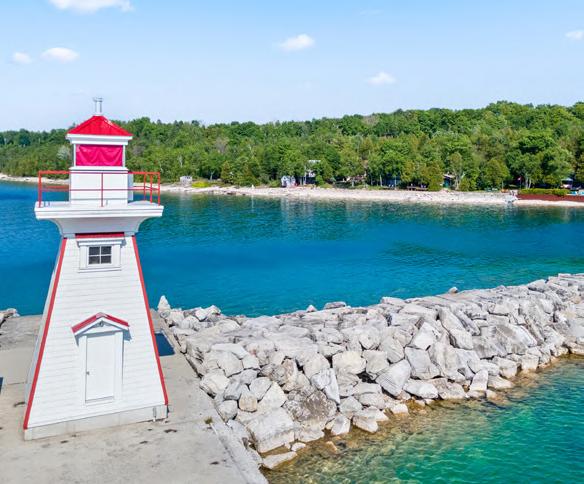

Go with the flow from Tobermory to Tiny with the spotlight on waterfront in Collingwood, Clearview, and Northern Bruce Peninsula. 47 Glen Road is a new, custom-built 3000 sq. ft home with 3 bedrooms, gourmet kitchen, private sandy beach, and a view to die for! Have the best of Georgian Bay living, handy to Collingwood’s vibrant downtown, Smash pickleball, and essential amenities.
The Noisy River runs through a lovely chunk of Clearview paradise that’s anything but noisy – and it’s a flat bike ride to the charming Village of Creemore. Live simply in the rustic board and batten cabin or build your dream home on the river. Those looking to really get away from it all can binge watch spectacular water views of Lion’s Head Bay on the Bruce Peninsula. A spacious, meticulously crafted waterfront bungalow offers gentle swimming, Bruce Trail hiking, and executive living – minutes from the community of Lion’s Head. Shake off the world with assets that sparkle, gurgle, and evolve with our beautiful seasons by contacting Max or James.

Max Hahne
Broker, IRES**, RSPS
†
James McGregor
Sales Representative, CIPS*


